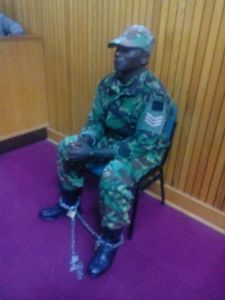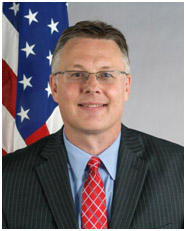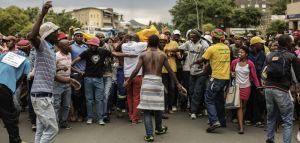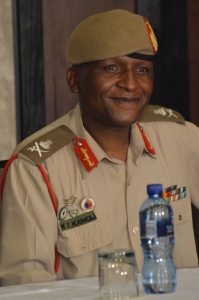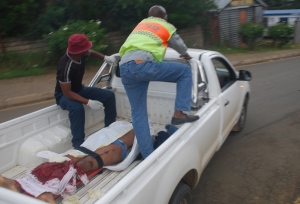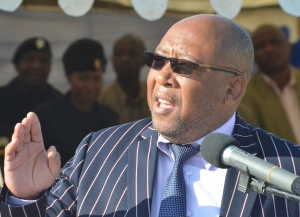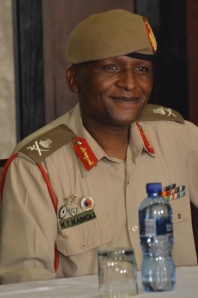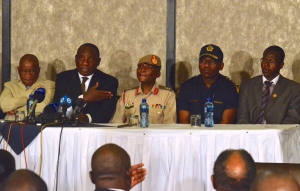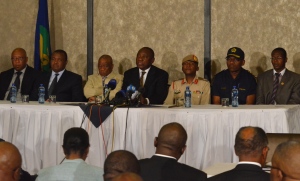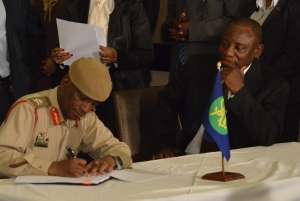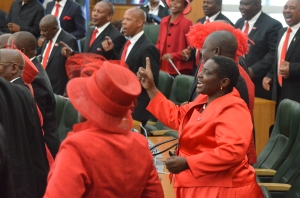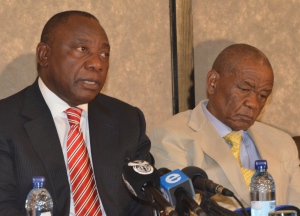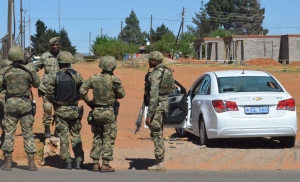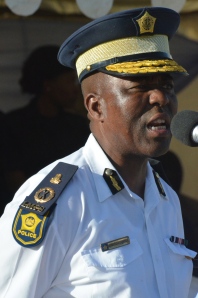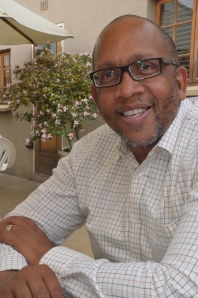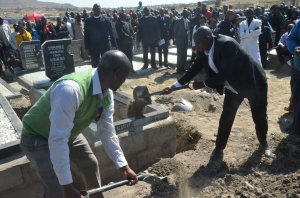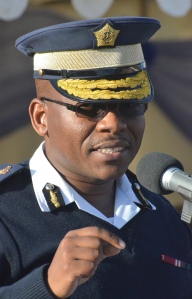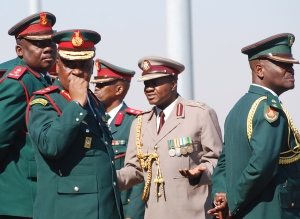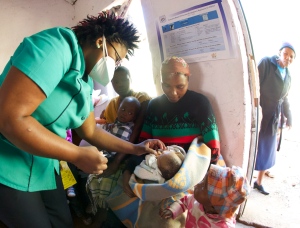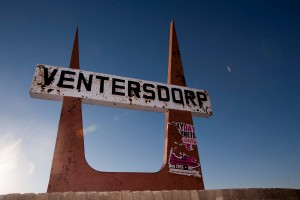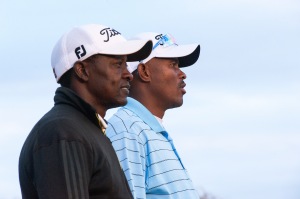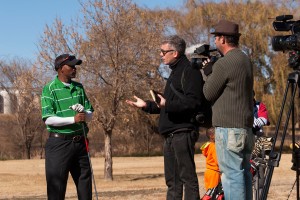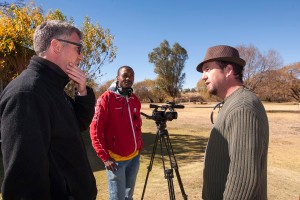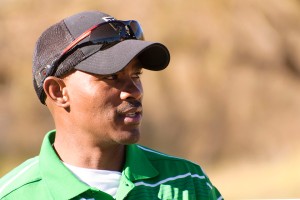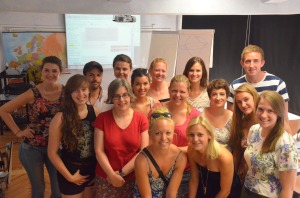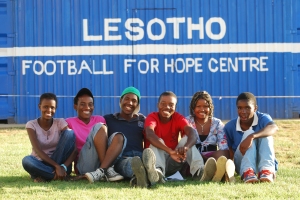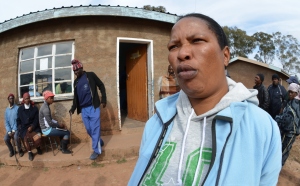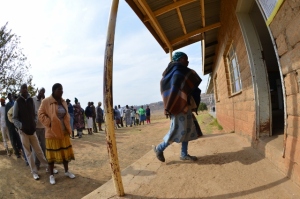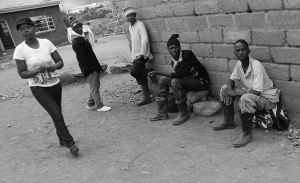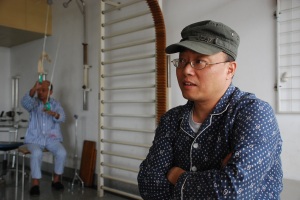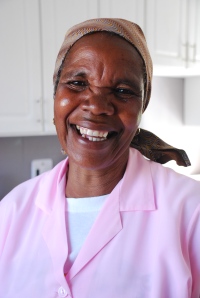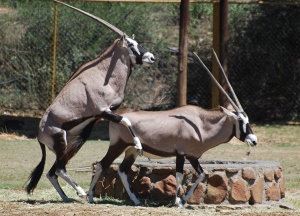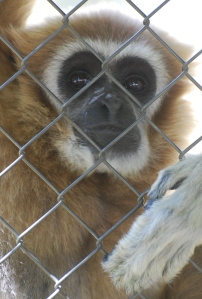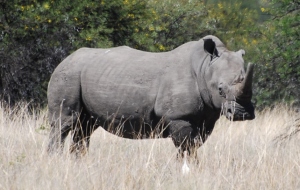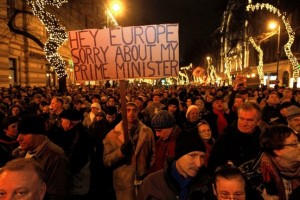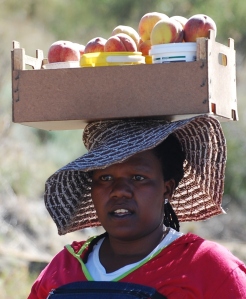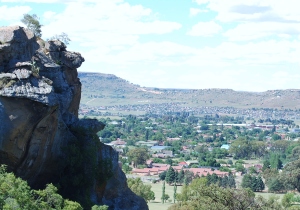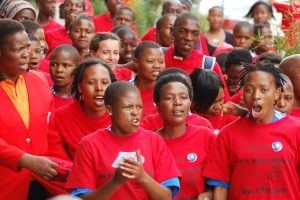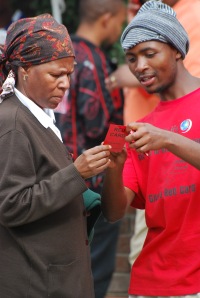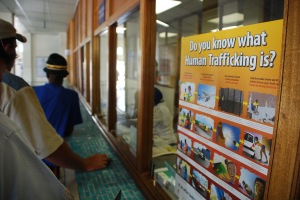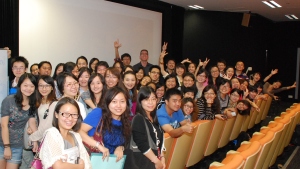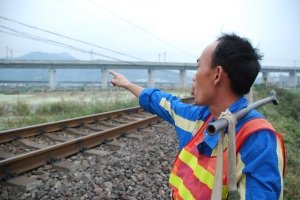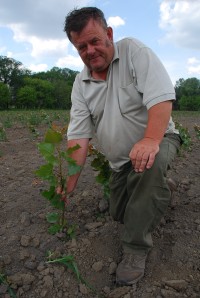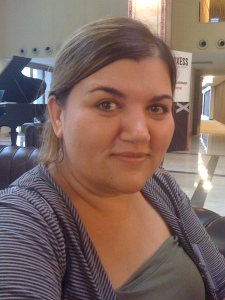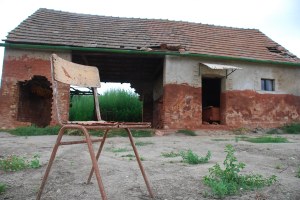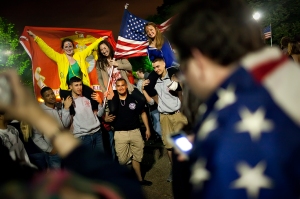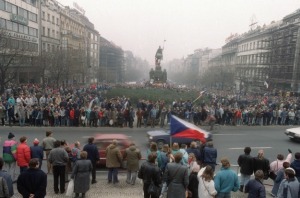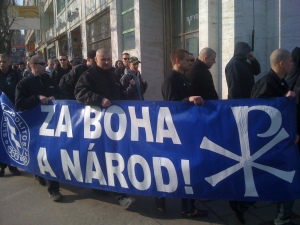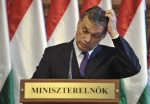MASERU, Lesotho – The passport is stamped U.S., but I’m unabashedly a citizen of the world, with a toehold on four continents: from New York to Hong Kong, Prague to Lesotho. As a foreign correspondent, journalism educator, Health and Development communications consultant, and father of three, I’m based in Lesotho, high in the mountains of southern Africa. As the lone Western correspondent here, I’ve covered the tiny Mountain Kingdom‘s unique political crisis for Foreign Policy, AFP, South Africa’s Mail & Guardian, and others. Meanwhile, I’m also teaching Health Journalism and storytelling in one of the world’s sickliest societies. And from next-door South Africa, I’m co-producing a documentary film – The Clubhouse: A Post-Apartheid Story – which explores racial healing and equal opportunity in The Rainbow Nation, twenty years later. At the same time, in Hong Kong, I’m a six-time Visiting Scholar teaching International Journalism, mostly to bright, young mainland Chinese; and in Prague, I’m Senior Trainer of a biannual course in storytelling from around the world. In fact, post-Communist Central Europe flows through my veins; that’s where I launched my own foreign-correspondent career two decades ago. Thank you for visiting my website – and for reading … Michael
Posted in "From East to East", Africa, Blogging, Central Europe, China, Eastern Europe, European Union, Hong Kong, Journalism, Lesotho, Parenting, Teaching, Writing | Tagged Basotho, Freelance Foreign Correspondent, Freelancer, Journalism Training, Lesotho, Maseru, Parenting, Sesotho | 4 Comments »
(This Op-Ed appeared July 3 on the South African website, The Daily Maverick.)
The real story moving forward in a tiny kingdom afflicted by HIV and malnutrition – and utterly dependent on foreigners for free HIV anti-retrovirals and extra food – is if the most influential of donors, the United States, sticks to its demand for accountability for those responsible for the events last 30 August. But responsibility is a complex beast. By MICHAEL J. JORDAN
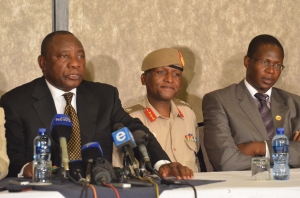
Cyril Ramaphosa, with Lt. Gen. Kamoli and Brigadier Mahao, as the SADC mediator answered a question at the Oct. 23, 2014, signing of the SADC security deal. (Photo by Michael J. Jordan)
JOHANNESBURG – In Southern Africa, ‘tis the season to celebrate the culture of impunity. To laugh in the face of accountability. To spit in the eye of the rule of law.
At the recent African Union summit, headlines were dominated by South Africa’s refusal to detain the accused war criminal, Sudanese President Omar al-Bashir, on behalf of the International Criminal Court.
The ANC – which under Nelson Mandela triumphed against one of the world’s most notorious regimes, yet today is led by a Jacob Zuma whose countless corruption charges have made him a laughing stock – was joined by the legendary strongman and noxious nonagenarian, Zimbabwean President Robert Mugabe, in declaring the ICC persona non grata in Africa.
Farther from the limelight, Lesotho Prime Minister Pakalitha Mosisili must have cracked a grin at all the hijinks. With his nation again swirling in crisis over the past month, how could he not interpret the AU anti-accountability spectacle as one more green-light for his new government to crack down? This one on top of the quiet consent of the Southern African Development Community (SADC), also led by Zuma and Mugabe.
Last week, a top military leader paid the price: with his assassination.
Maaparankoe Mahao, the Lesotho Defence Force Brigadier appointed last year to replace the intransigent Lieutenant General Tlali Kamoli as LDF commander – then, after Kamoli responded with a bloody coup-attempt last Aug. 30, became a central figure in SADC’s crisis-resolution efforts – was shot and killed in broad daylight, while driving his family. As two of his nephews watched.
SADC is now mouthing more empty words of “concern” for a Lesotho upon which South Africa has grown dependent for the vital water it pumps into Johannesburg: Zuma sent a fact-finding mission this weekend, followed Tuesday by a visit from the lead SADC mediator to Lesotho, Deputy President Cyril Ramaphosa. Lesotho is suddenly, even embarrassingly, back atop the SADC agenda.
Yet the real story moving forward in a tiny kingdom afflicted by HIV and malnutrition – and utterly dependent on foreigners for free HIV anti-retrovirals and extra food – is if the most influential of donors, the United States, sticks to its demand for accountability for those responsible for the 30 August events. Or else.
In the process, this dramatic showdown has suddenly turned Lesotho into an illuminating case-study on the limits of international-development assistance.
Posted in "From East to East" | 1 Comment »
(For more of my reporting on the “criminal cover-up” in Lesotho, read this March 24 piece South Africa’s Daily Maverick. For a more sweeping piece on Lesotho’s post-Aug. 30 crisis, read my Feb. 27 piece for Foreign Policy.)
MASERU, Lesotho – With Lesotho swirling in crisis once more, a symbolic anniversary almost slipped by without me noticing.
Seems hard to believe now, but just three years ago, Lesotho was hailed as a democratic trailblazer, setting a new standard for all of southern Africa.
High in the pristine Maloti mountains, this tiny African kingdom – its half-a-century of independence scarred by military coups, political violence and blood-stained elections – pulled off a national election that saw a peaceful handover of power, followed by creation of one of Africa’s rare coalition governments.
I was still new to Lesotho, wet behind the ears after living in Africa only six months. Nevertheless, from that election, I produced my first foreign reporting from Lesotho. For The Christian Science Monitor, Democracy 101: Tiny Lesotho Holds Peaceful Elections. For The Global Post, Lesotho Leads Southern Africa in Democracy.
Amid so much gloom about the health crisis gripping the entire Basotho nation, this political achievement provided a ray of hope. Three years later, then … Happy Anniversary, Lesotho Democracy!
Right? No, nothing to celebrate in The Mountain Kingdom. Here are the headlines of three leading weeklies, over the past few days:
*From The Post, Kamoli Cracks the Whip: As in Lt. Gen. Tlali Kamoli, the “renegade” commander of the Lesotho Defence Force who reportedly led the Aug. 30 coup-attempt. Now reinstated with nary an inquiry clearing him of treason-and-murder charges. Army-linked mayhem of recent days moved US Ambassador Matthew Harrington to wonder aloud if “the LDF is doing as it pleases.”
Posted in "From East to East" | 4 Comments »
(For more of my reporting on the “criminal cover-up” in Lesotho, read this March 24 piece South Africa’s Daily Maverick. For a more sweeping piece on Lesotho’s post-Aug. 30 crisis, read my Feb. 27 piece for Foreign Policy.)
MASERU – In Lesotho – a country marked by high-level lawlessness over the past year – one heavyweight has finally demanded “accountability” … or else.
On Wednesday, U.S. Ambassador to Lesotho Matthew Harrington clarified that Washington hasn’t “threatened” to cut aid or freeze programs over troubling steps the new government has taken since snap Feb. 28 elections.
However, Harrington didn’t rule out the possibility that the Millennium Challenge Corporation may deny Lesotho a second massive “compact” this December.
From 2008-2013, the MCC gave Lesotho a whopping $362.55 million for health, water and private-sector projects, including 138 new or renovated health clinics — in a country that according to all major health indicators, is one of the sickliest in the world. (This on top of the $225 million the US has given here since 2007, through PEPFAR, to combat HIV/AIDS in Lesotho, which suffers the world’s second-highest rate of infection. For those keeping score, that’s nearly $600 million for a tiny African kingdom few Americans have even heard of.)
Yet a key MCC provision is “accountability,” which in Lesotho includes “accountability for the events of Aug. 30,” Harrington said. “The MCC has made very clear that accountability will be taken into consideration – and we’ll be watching very carefully if anyone will be held accountable for the actions of that day.”
The US has been largely silent during the months of crisis-resolution efforts, deferring to Lesotho’s neighbors and the regional powerhouse: the Southern African Development Community, led by South Africa. Yet not once during months of mediation did SADC seek “accountability” for Aug. 30 — or try to tackle Lesotho political-violence itself.
Today, though, more Basotho, especially within the suddenly emboldened, vocal civil-society circles, are looking to the two leading “beacons of democracy” in Maseru — the US Embassy and European Union Delegation — to help them defend the rule of law. (The EU has yet to speak up, as the US now has.)
Harrington, who, to be fair, only arrived on the job weeks after the Lesotho crisis erupted, on Wednesday made his strongest comment to date about the whole affair. Continue Reading »
Posted in "From East to East" | 1 Comment »
MASERU – With Lesotho civil-society now finding its voice, below are a series of short dispatches I posted to my Facebook account.
MAY 26, 2015: In Lesotho, is something brewing at the grassroots – finally? After the Lesotho Council of NGOs rallying cry on May 21 for “rule of law” [SEE DISPATCH BELOW], yesterday, the other leading voice of Lesotho civil society, the Transformation Resource Centre, went one step further: pointing fingers.
The TRC press-release: “Condemnation of abductions, assassination plots and threats against courts of law by elements of the Lesotho Defence Force.” Moreover, the TRC states that it now has the ear of the International Criminal Court, but is calling on victims to produce concrete “evidence” in order to stop “these acts of terror, perpetrated by elements of the state.”
One Basotho analyst today helps me connect the dots: “Basotho are a patient nation, sometimes too patient.” But, “are slowly waking up to their rights.” Still no Lesotho government reaction, it seems. Meanwhile, will the Lesotho media now bravely turn watchdog, to dig deep and separate fact from fiction?
MAY 25, 2015: Just read a remarkable – and very BRAVE – May 21 statement from the Lesotho Council of NGOs “Democracy and Human Rights Commission.” At a time when some suggest it’s only a boy-who-cried-wolf opposition howling about threats of political-violence, the LCN speaks out about the “feeling of insecurity” in Lesotho, the lack of “rule of law”, the handling of LDF that jeopardizes “peace and security”, etc. LCN calls on all African, Western, international partners to “condemn any action” harming Lesotho’s “democracy and human-rights culture.” So, the question is: who will have the LCN’s back? Who – if anyone – will join their brave stance? Even defend Lesotho civil society, if needed, after sticking its neck out like this? Bravo, LCN.
Posted in "From East to East" | Leave a Comment »
MASERU, Lesotho — Is Lesotho starting to unravel … again? Clues abound.
First, the shooting death of a Basotho businessman close to the ousted ex-Premier Thabane and his ABC party – with whispers of army involvement. Then, the alleged “kidnappings” of Lesotho Defence Force soldiers by fellow army comrades.
And now this, yesterday: Thabane, the new opposition leader, flees back to South Africa for a second time — claiming an assassination plot against him.
In November, I reported for AFP about another alleged plot to kill Thabane — but that was never substantiated. (And forced me to realize how much misinformation and disinformation permeated the otherwise fresh air of Lesotho.)
Nevertheless, is it time yet for more Cyrial Ramaphosa mediation — on behalf of the Southern African Development Community (SADC) — which ignored Political Violence in Lesotho, the first time around?
Posted in "From East to East" | Leave a Comment »
MASERU, Lesotho – Dear friends! I’m pleased to announce a “status” update.
I returned to post-crisis #Lesotho last month, after another memorable stint with my student-journalists in Hong Kong. Back in Lesotho, I’ve shifted away from the “Corruption and Political Violence” beat I made my own since September. Instead, today I wear a different hat: as a Health Communications Consultant.
In the country that suffers the world’s second-highest rate of HIV infection (a mind-boggling 23%!) – where UNICEF figures suggest that more than 10 percent of the entire populace has been orphaned by one or both parents – I’m proud to lead a storytelling project about the most innocent victims of the HIV epidemic: the Basotho children categorized as “Orphans and Vulnerable Children.”
I’m particularly pleased to be doing this project for one US NGO on the frontlines of this great national tragedy, Management Sciences for Health. MSH, with financial support from USAID, has nurtured a small army of grassroots Lesotho NGOs, all of them scattered among the rugged Maluti mountains.
Since that 23%-figure hasn’t budged in more than a decade (!), from my perch here in the capital — and from the perspective of an international community largely focused on the HIV epidemic — it’s easy to conclude that “nothing” is being done to fight HIV in Lesotho. Now I know better.
Last week I visited the first handful of Lesotho NGOs, who raise awareness of HIV, malnutrition, abuse of children, and other topics among the peaks and valleys around Qacha’s Nek and Mohale’s Hoek. If it weren’t for these social workers and community activists – and their battalions of primary and secondary caregivers in virtually every embattled village – I’d be more pessimistic about HIV in Lesotho.
More on that soon! Updates to come. One objective of mine is to raise awareness about this entire OVC calamity, as it also opens a window onto all the health and development challenges that confront Lesotho – and southern Africa itself.
Thank you for reading!
Posted in "From East to East" | Leave a Comment »
(The following commentary was published March 24 by South Africa’s Daily Maverick. For more on Lesotho’s crisis, read my recent piece for Foreign Policy.)
For better or worse, Lesotho has moved on from last year’s constitutional crisis. But how much do we really know about the attempted coup (or was it?) that sparked all the troubles on that fateful August day?
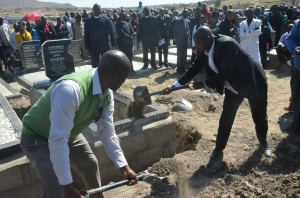
Will the family of Mokheseng Ramahloko — the lone man killed Aug. 30 — receive justice? (Photo: mjj)
By MICHAEL J. JORDAN
In crisis-struck Lesotho, democracy has prevailed – and a criminal cover-up continues.
Prime Minister Pakalitha Mosisili, who served as premier from 1998 to 2012, was sworn in last week for his second stint in power: the inauguration cemented Lesotho’s second straight peaceful handover of power, while ushering in its second straight coalition government – both rare achievements in sub-Saharan Africa.
Yet, with the snap February elections coming six months after a coup attempt that rocked the tiny African kingdom, this is a hollow victory for democracy – even with the imprimatur of well-meaning outsiders. As the Daily Maverick’s Simon Allison astutely observed, Lesotho has experienced a bloodless “democratic coup.”
Indeed, nothing exposes this sham – perpetrated by the new leadership, with the ongoing complicity of their foreign enablers – more than the whitewashing of the putsch that sparked Lesotho’s political-security crisis in the first place.
The enduring mystery of what exactly happened that day – who did what and why – would, if exposed, likely destabilise Lesotho once more. It would also rattle surrounding South Africa, which relies heavily on Lesotho’s water. And it’d unravel the desperate, quick-fix efforts by the Southern African Development Community (SADC) – the region’s diplomatic bloc, led by South Africa itself – to restore “peace and security” to Lesotho. In other words, it’s in no one’s interest to unlock the truth.
Not once, during the six months of SADC “facilitation” efforts, up through today, have SADC officials – particularly its lead mediator in Lesotho, South African Deputy President Cyril Ramaphosa – touched on the mutinous army revolt on 30 August last year.
Posted in "From East to East" | 1 Comment »
(The following Dispatch was published Feb. 27 on ForeignPolicy.com. For more of my reportage on other root-causes of Lesotho’s crisis: high-level corruption, ongoing political violence, the untamed military.)
As southern Africa’s democratic success story Lesotho goes to the polls, the prime minister’s anti-corruption crackdown has brought a bitter power struggle into the streets.
By
MASERU, Lesotho — On Feb. 1, just outside the gates of the Royal Palace in this tiny African kingdom, shots rang out, shattering the Sunday afternoon quiet.
Two bodyguards of Prime Minister Tom Thabane exchanged a hail of gunfire with soldiers from Lesotho’s defense force. When the shootout was over, both bodyguards and at least one soldier had been wounded. A bystander, reportedly hit by 23 bullets, was killed. It’s still unclear who fired first. The incident — sudden and bloody on the streets of the capital, Maseru — thrust a bitter power struggle between the ruling coalition government and its adversaries back into daylight.
It was only two years ago that Lesotho, a mountainous enclave of not quite 2 million people, fully encircled geographically by South Africa, appeared to be a new democratic success story in sub-Saharan Africa.
Despite having a past marred throughout its half-century of independence by military coups and post-election violence, the constitutional monarchy pulled off a stunning political achievement: Lesotho’s 2012 parliamentary elections produced a peaceful handover of power from longtime Prime Minister Pakalitha Mosisili to the feisty opposition (which had been persecuted after splitting from the ruling party in 2006). And the new leadership went on to create one of the continent’s rare coalition governments.
But now, only days away from the country’s critical parliamentary elections set for Feb. 28 — which are being overseen by a regional body, the Southern African Development Community (SADC), that has refused to publicly acknowledge the high-level corruption and political violence at the root of the unrest — that shootout may have been a harbinger of worse things to come.
With shared roots in the country’s first post-independence party, the factions are distinguished more by personality than politics, with little difference between their ideologies. But as one civil servant who requested anonymity said, “Whichever side doesn’t get to be a part of the next government, I’m afraid they will cause some troubles — I think they’ll fight.”
Posted in "From East to East" | Leave a Comment »
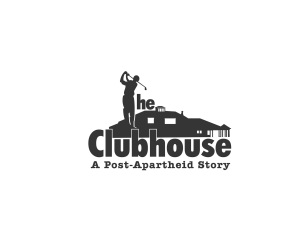 Dear friends and supporters! My partner Danny and I are thrilled to unveil our new promo for our documentary film on racial healing in The New South Africa, twenty years later – The Clubhouse: A Post-Apartheid Story.
Dear friends and supporters! My partner Danny and I are thrilled to unveil our new promo for our documentary film on racial healing in The New South Africa, twenty years later – The Clubhouse: A Post-Apartheid Story.
Click here to view it. The top-notch cinematography is drawn from our last production trip to Ventersdorp, which many of you helped fund. We would’ve gotten this trailer out sooner, but Lesotho erupted in crisis. And, well … duty called!
That said, we’d never forsake this film. Step by step, we’ll get there. Do let us know what you think of the promo.
Meanwhile, if you’d like to read my six-part travelogue on the making of this film, please click here. Thank you!
Posted in "From East to East" | Leave a Comment »
(The following piece appeared Feb. 19 in South Africa’s Mail & Guardian. For more on another root-cause of Lesotho’s crisis – political violence – please click here. For more background on Lesotho’s security accord, click here.)
 The nerves of the coup-prone mountain kingdom are frayed as a SADC-monitored poll nears to return it to political stability.
The nerves of the coup-prone mountain kingdom are frayed as a SADC-monitored poll nears to return it to political stability.
MASERU, Lesotho – In the first few months after Lesotho’s crisis erupted in August, much of the blame was pinned on the aggression of the country’s military commander, Lieutenant General Tlali Kamoli. But now, just days before the kingdom’s Feb. 28 election aimed at resolving the impasse, there are indications that Prime Minister Tom Thabane may have an entire rogue military on his hands.
The Aug. 30 coup attempt saw Lesotho Defence Force (LDF) soldiers chase Thabane from his official residence across the South African border. Simultaneously, troops attacked three police stations, killing one officer and injuring nine others.
For South African Deputy President Cyril Ramaphosa, the lead mediator in the crisis for the Southern African Development Community (SADC), a crowning achievement came in November when he exiled Kamoli from Lesotho. Cut off the snake’s head, went the rationale, and then nurture unity between the army and police, and between the army and a democratically elected civilian command.
Yet today, ahead of the poll SADC moved forward by two years, the LDF has made a move that shows just how big the problem is. On February 13, the military issued a one-page declaration stating that, “in its quest to fulfil its mandated duties to protect the Basotho nation”, it would immediately begin “patrols and vehicle checkpoints” in “various places” nationwide.
Ramaphosa scrambled to nip this exercise in the bud, producing an agreement in which the government, the LDF, the police and Lesotho’s Independent Electoral Commission (IEC) agreed that the army will “remain in barracks” and “only assist” if the IEC requests it. Nevertheless, this manoeuvring by the LDF has sparked fears that voters may be intimidated or that violence may break out.
“The saddest part is that the prime minister, as commander-in-chief, is helpless to do anything about the LDF,” said a Basotho businesswoman, who insisted on anonymity. “SADC and Ramaphosa must be very clear: if they’re truly for a lasting peace in Lesotho, they must bring the LDF to order and depoliticise them.”
Posted in "From East to East" | 1 Comment »
(The following piece appeared Feb. 13 in South Africa’s Mail & Guardian. For more on another root-cause of Lesotho’s crisis – corruption – please click here.)
 After a deadly shooting earlier this month, the SADC is being criticised for ignoring the cause of Lesotho’s crisis: political violence.
After a deadly shooting earlier this month, the SADC is being criticised for ignoring the cause of Lesotho’s crisis: political violence.
MASERU, Lesotho – It’s a season of denials in Lesotho. On Sunday, Feb. 1, the afternoon calm in the capital Maseru was shattered by the crackle of gunfire in the street just outside the gate of King Letsie III’s royal palace.
Two of Prime Minister Tom Thabane’s bodyguards, travelling alone, were shot and wounded. At least one Lesotho Defence Force (LDF) soldier was also shot and wounded. A private security guard, drawn by the din, was killed in the crossfire.
The government says troops fired first. The LDF deny this, saying Thabane’s men (soldiers themselves) fired first – at a checkpoint the LDF set up to protect the Maseru headquarters of the Southern African Development Community (SADC), here to “restore peace and security” after last August’s coup attempt in which soldiers raided Thabane’s official residence and the national police headquarters, killing one police officer and injuring nine.
But SADC says it did not invite LDF protection that day. Days later, Lesotho’s government says four LDF soldiers were arrested in South Africa on their way to “finish the job” – of killing Thabane’s two bodyguards as they recovered in a Bloemfontein hospital.
The South African Police Service denies this: “No one has been arrested.”
What no one denies, though, is that in a country plagued by a long history of political violence, especially around elections, the Feb. 1 shoot-out was yet another act of political violence. Coming just weeks before the critical February 28 elections – which SADC moved up two years earlier to restore “normalcy” to the mountain kingdom – it is causing concern.
“When we hear about soldiers shooting at each other, people dying, conflicting statements about why exactly soldiers were there, it causes confusion and fear for ordinary Basotho,” says Sofonea Shale, co-ordinator of Development for Peace Education, a leading voice of civil society. “When a security guard is caught in the crossfire, don’t think violence is too far from you. Tomorrow, that could be you.”
Posted in "From East to East" | Leave a Comment »
(The following commentary was published Feb. 13 by South Africa’s Daily Maverick. It was also published a day earlier on The Mantle in New York.)
It’s not all doom and gloom in tiny Lesotho – although between the healthcare crisis, the spiralling unemployment and the dangerously messy political situation there is enough of that to go around too. MICHAEL J. JORDAN profiles the youth-driven peace concert that demands a brighter future.
MASERU – In a sea of unrelenting bad news around the world, we in the media should sometimes look harder for good news. Especially for me today, an outsider up to my ears in a tiny African kingdom I’ve grown to care about deeply.
With Lesotho and its mind-boggling range of health, development and democratization challenges – and now mounting fear of imminent election-related violence – it’s simply too easy to write about the negatives.
That’s why I’m stunned to have stumbled across a genuinely positive story: a new Basotho-youth organization unveiled its plan to host a huge pro-peace concert, Stand United Music Festival -this Saturday, Feb. 14, two weeks before the vote.
At first I dismissed the concert as a cute idea, but not necessarily news-worthy. Now I see a greater symbolism, which even inspires me to write about it.
Let me explain. Though, first a disclaimer: I’m not writing this piece because my documentary-film partner is a co-organizer, or that my wife works for one of the sponsoring agencies. (Let them do their own damn PR! Or, check their poster.)
No, I write for two reasons. We journalists have an obligation to seek out “good news,” as well. Sure, bad news, especially scandalous stories, help “sell papers.” But we have a duty to our audience to be as fair and accurate as possible. Disproportionate focus on the negative – the low-hanging fruit – may present a distorted image of a society. Particularly, when reporting from faraway lands.
For example, I now live next door to South Africa, and all I hear about it is crime, corruption, cronyism and incompetence. Surely there are some positive trends to report about “The Rainbow Nation,” two decades after Apartheid?
Now the second reason: the media must also recognize the vital role we play in shaping and influencing a national psyche.
Posted in "From East to East" | Leave a Comment »
By Michael J. Jordan
MASERU, Lesotho – A top Lesotho official has distanced his government from a Minister’s assertion last week that four Lesotho soldiers were arrested in neighboring South Africa, while on their way to “finish off” two of Prime Minister Tom Thabane’s bodyguards – as they lay recovering from a recent shootout.
“At my disposal, I don’t have any concrete information to confirm or not to confirm these arrests,” Government Secretary Moahloli Mphaka said Wednesday.
Lesotho is two-plus weeks from Feb. 28 elections intended to restore peace and security, after a coup attempt convulsed the tiny African kingdom last August.
The Feb. 1 shootout in broad daylight between Lesotho soldiers and Thabane’s two bodyguards sparked fears in a country plagued by bouts of election-related violence during its half-century of independence. It also spurred greater criticism of mediation efforts by the regional peace-and-security bloc, the 15-nation Southern African Development Community (SADC).
Home Affairs Minister Joang Molapo then ratcheted tensions on Feb. 5, when he announced that four heavily armed Lesotho Defence Force soldiers were arrested on their way to the provincial South African hospital where the two bodyguards – soldiers themselves, who had reportedly tipped off Thabane about the Aug. 30 putsch and helped him escape into South Africa – lay wounded.
“We believe the four arrested intended to finish off the soldiers who they didn’t kill” earlier, Molapo told AFP. Molapo, though, declined to provide their names or location, for the claim to be verified. An LDF spokesman denied the arrests, saying all soldiers were accounted for in Lesotho.
Two days later, South African Police Service National Spokesman Solomon Makgale told AFP: “The SAPS has not arrested Lesotho soldiers.”
From the Lesotho government, this was the latest sensational claim of security threats, without providing evidence – in a political atmosphere filled with unsubstantiated accusations between the government and its opponents.
Posted in "From East to East" | Leave a Comment »
(The following article was published Feb. 6 by international news agency AFP.)
Maseru (Lesotho) (AFP) – Four Lesotho soldiers have been arrested in South Africa where they planned to kill two of the prime minister’s bodyguards recovering in hospital, Home Affairs Minister Joang Molapo said Friday.
The bodyguards were wounded in a shootout in Lesotho’s capital Maseru on Sunday, allegedly because they foiled an August 30 army coup attempt by tipping off Prime Minister Tom Thabane and helping him escape across the South African border.
With tensions mounting ahead of elections on February 28, the wounded bodyguards — who are also soldiers — are wanted dead, Molapo told AFP.
“We believe the four arrested intended to finish off the soldiers who they didn’t kill on Sunday,” he said.
Molapo added that the two bodyguards had been moved from hospital in Bloemfontein to a “more secure” medical facility in South Africa.
As of late Friday, South African police had yet to confirm the claim. “For now, we have no information about the alleged arrest,” SAPS National Spokesman Gen. Solomon Makgale told AFP.
A Lesotho Defence Force spokesman earlier this week denied that the bodyguards had been targeted, saying they had fired first after ignoring an army checkpoint. The spokesman could not be reached Friday to comment on the latest charge against his soldiers.
Molapo said he would join a Thabane-led delegation to Pretoria on Friday, to discuss the tiny African kingdom’s “deteriorating security situation” and other election-related issues with South African President Jacob Zuma.
Posted in "From East to East" | 1 Comment »
(The following article was published Feb. 2 by international news agency AFP.)
Posted in "From East to East" | Leave a Comment »
(The following article was published Feb. 1 by international news agency AFP.)
Posted in "From East to East" | Leave a Comment »
(The following Op-Ed was published Jan. 28 by South Africa’s Daily Maverick.)
Journalists are the primary watchdogs in any democracy, but what happens when those watchdogs lose their bite? In Lesotho, a pliant, uncritical media is failing to hold anyone to account in the run-up to the February elections. By MICHAEL J. JORDAN
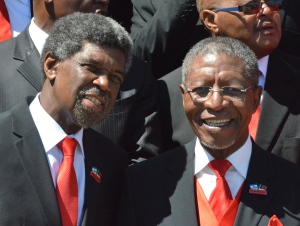
Former Prime Minister Pakalitha Mosisili (right), and his #2, Monyane Moleleki, a former Minister of Natural Resources accused of fixing diamond contracts, may be hoping to sweep away all corruption cases. (Photo: mjj)
Maseru, LESOTHO – For any democracy to thrive, its media must act as watchdog – holding leaders accountable for their words and deeds. And, yes, take a bite if they fail to deliver.
That’s why it’s so troubling to see how toothless my colleagues in the Lesotho media truly are, especially when their nation needs them most – one month away from the critical 28 February elections. Basotho voters must choose which leaders to entrust with guiding them out of months of political and security crisis, sparked by 30 August coup attempt.
There’s more at stake than the fate of a tiny mountain kingdom that just two years ago was touted as a democratic success in Africa for its peaceful handover of power – yet was derailed by its sixth putsch in half a century of independence, which laid bare endemic corruption and political violence.
More broadly, there may be repercussions for the regional power, the 15-nation Southern African Development Community. Lesotho is the latest test of SADC’s ability to resolve conflicts, yet its lead mediator, South African Deputy President Cyril Ramaphosa, hasn’t uttered a word in public about the root causes of corruption and political violence. If this election spawns bloodshed, would South Africa have to send in troops – as in 1998?
Then there’s the international community. It’s spent well over $1 billion in foreign aid over the past decade to help the Basotho tackle their severe health, development and economic challenges – yet has little to show for it. Just the opposite, in fact: the HIV rate refuses to budge from 23 percent, and Lesotho is sliding down the UN Human-Development Index. The prime culprits: corruption, cronyism, incompetence and pervasive apathy.
So, which Basotho politicians, parties and ministry officials would foreign donors prefer as their next set of partners, especially as some deepen their investment here? Or would it be time for the international community to consider whether to pull out of Lesotho – as the Irish Embassy did last year (though Irish Aid remains) – and devote their dollars elsewhere in sub-Sahara Africa?
Back to the Basotho journalists, then. With Lesotho facing this fork in the road, the burden of a noble mission falls to the media: to better inform and educate society, enabling voters to make wiser decisions about whom to elect. Who’s telling the truth? Who isn’t? Who’s delivered results? Who hasn’t? And why? Continue Reading »
Posted in "From East to East" | Leave a Comment »
(The following article was published Dec. 12 by South Africa’s Mail & Guardian.)
 The tiny country struggles to prosecute highly placed politicians accused of financial crimes.
The tiny country struggles to prosecute highly placed politicians accused of financial crimes.
By Michael J. Jordan
MASERU, Lesotho – Timothy Thahane, former Lesotho finance minister and a former deputy governor of the South African Reserve Bank, has been accused of defrauding a Lesotho farming project of R24-million.
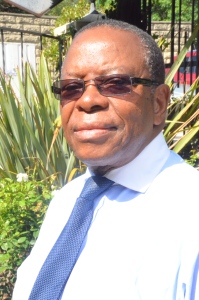
Ex-Finance Minister Thahane claims his innocence. “Don’t put me in league with others accused,” he told me. (Photo: mjj)
And he’s not alone, but just one of a handful of current and former Lesotho ministers who are accused of corruption. Yet none of them has been tried in court – let alone prosecuted.
Last month Thahane’s lawyer, Qhalehang Letsika, astonished the country’s high court with his reason for why the judge should once again postpone the trial of the 74-year-old. He admitted he had proposed the November court date in September, but the court hadn’t confirmed the date with him, so he wasn’t prepared to proceed.
High court Justice Tseliso Monaphathi expressed his frustration: “It now seems to be the tradition to postpone these high-profile cases … this should not be tolerated. It affects the reputation of this court and all the courts in this country.”
Letsika told the Mail & Guardian this week: “The intention is not that my client shouldn’t have his day in court. We are ready to appear in court, defend his rights and prove that the charges are baseless.”
But this is more than a saga of how one tiny African country struggles to prosecute financial crimes perpetrated at the highest levels, which ultimately hinder its development. The ruling coalition also asserts that corruption is a root cause of Lesotho’s current crisis sparked by an August 30 coup attempt.
Posted in "From East to East" | Leave a Comment »
(For more on the initial accusation against SADC commanders, please click here.)
By Michael J. Jordan
MASERU, Lesotho – Three weeks later, it’s unclear if the Southern African Development Community has sent home two commanders assigned to protect top leaders in tiny, crisis-struck nation, but whom Lesotho’s government then accused of leaking information that jeopardized Prime Minister Tom Thabane’s security.
Neither government officials nor SADC officials want to discuss it – in a country still swirling with rumors and accusations since an Aug. 30 coup attempt.
“There is no further information to share, as this is a matter between the government and SADC,” Government Secretary Moahloli Mphaka said Friday.
Mphaka sent the letter to SADC on Nov. 17, on behalf of Thabane’s government, and said he expected rapid removal of two men they accused of detailing the premiere’s movements in secret meetings with opposition forces.
Lesotho is still unnerved by the putsch three months ago, in which soldiers reportedly raided Thabane’s official residence – forcing him to flee into South Africa – and a simultaneous assault on three police stations that killed one cop.
Heavily armed police protection for Thabane and other top officials has since been provided by SADC, the 15-nation bloc responsible for regional peace and security, and by its most influential member, South Africa.
Thabane spokesman Thabo Thakalekoala said SADC police told him the two commanders “have left the country for their country of origin,” however, SADC itself refused to confirm this.
Posted in "From East to East" | Leave a Comment »
(The following article was published Dec. 5 by international news agency AFP. For more about the SADC plan for “lasting peace” in Lesotho, please click here.)
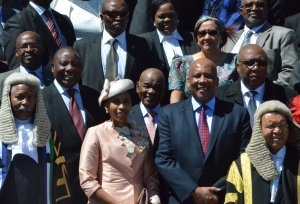
King Letsie III, who dissolved Parliament on Friday, here at its landmark re-opening on Oct. 17, flanked by Queen ‘Masenate, with Ramaphosa and Thabane behind them. (Photo: mjj)
Maseru (Lesotho) (AFP) — Lesotho’s King Letsie III dissolved parliament on Friday ahead of a February election designed to restore peace to the kingdom after an attempted coup.
The dissolution is part of a peace deal reached by a regional bloc, the Southern African Development Community (SADC).
“This shows that we are complying with the SADC roadmap to bring peace and security back to Lesotho,” Thabo Thakalekoala, spokesman for Prime Minister Tom Thabane, told AFP.
The tiny kingdom which is surrounded by South Africa, last held elections in 2012, which resulted in a shaky coalition government.
Matters came to a head with the August 30 putsch, when soldiers raided the official residence of Prime Minister Tom Thabane, causing him to flee into nearby South Africa. The attempted coup exposed friction between the Lesotho military and the police, pushing the country to the brink of a full-blown conflict.
Early last month, South Africa’s deputy president Cyril Ramaphosa helped broker a political agreement that re-opened parliament for the first time since June and pushed forward national elections by more than two years.
Posted in "From East to East" | Leave a Comment »
(The following article was published Dec. 4 by South Africa’s Mail & Guardian.)
 The mountain kingdom needs a robust, confident media to cover events without fear or favor. But it’s unlikely in this polarised society.
The mountain kingdom needs a robust, confident media to cover events without fear or favor. But it’s unlikely in this polarised society.
By Michael J. Jordan
MASERU, Lesotho – The barbs are flying at me faster, flung by a hostile crowd.
Here I am, the lone Western correspondent in this tiny African kingdom that still feels volatile since the August 30 attempted military coup that sent the nation’s prime minister scurrying next door into South Africa.
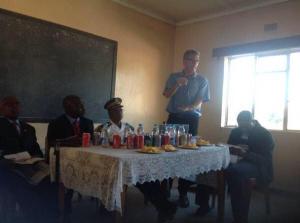
Ambushed on Nov. 25 to discredit my reporting, I resisted. Though, I apologized for its “unintended consequences.” (Photo: Irene Seme/Public Eye)
I am suddenly on trial, as a kangaroo court deals me a harsh lesson – and reveals what a minefield Lesotho is for journalists covering this crisis. Specifically, I’m forced to defend my reporting on the latest, Hollywood-worthy claims: “Lesotho hunts foreign ‘mercenaries’, fears assassination plot”.
A top government official alleged that Nigerian and Ghanaian soldiers-for-hire had slipped into the country, armed to the teeth, to hatch a plot to assassinate Lesotho’s leaders – to throw the tiny nation into even deeper crisis and harpoon the February 2015 elections, already moved up two years early by South African Deputy President Cyril Ramaphosa, who is mediating to restore some semblance of “lasting peace” here.
For the “mercenaries” claim, I’d asked two people if there was any clue on the identity of these alleged assassins. Thesele Maseribane, the third leader of the ruling tripartite coalition (who’s also the minister of gender and youth, sports and recreation) floated two nationalities: Nigerians and Ghanaians. Then I spoke to the police’s assistant commissioner of police, Sello Mosili, who confirmed this. So that’s what I reported – their allegations.
Some online media – in Lesotho, too – focused on the nationalities. Even worse, one weekly here turned my story’s allegation into their story’s fact: “Police hunt Nigerian, Ghanaian mercenaries.”
That sensationalist twist unfortunately sparked anxiety among the hundreds of Nigerians and Ghanaians living in Lesotho. They say it’s led to unkind comments from Basotho and feeling threatened on the streets.
Posted in "From East to East" | 1 Comment »
MASERU, Lesotho – Where are the Basotho voices?
It’s World AIDS Day in Lesotho – now the world’s second-most infected, with so many discouraging stats.
One thing I’ve learned after three years here, about the limits of international-development assistance: Lesotho needs Basotho champions.
Just as Magic Johnson did in the U.S. in 1991, brave Basotho in Lesotho must step up to say: “I’m the face of HIV; enough of this deadly stigma.”
Likewise, it’d really help if a brave Lesotho official were to step forward: “I’m the face of corruption; enough of the greed that stunts our growth.”
Though, I’d settle for one out of two …
Posted in "From East to East" | Leave a Comment »
(The following article was published Nov. 19 by international news agency AFP. For more about the claims of foreign “mercenaries” in Lesotho, please click here.)
Maseru (Lesotho) (AFP) — Lesotho has demanded the expulsion of two senior officers from a SADC police mission, accusing them of sabotaging the security of Prime Minister Tom Thabane and other top officials.
In a confidential letter to the Southern African Development Community and its lead negotiator Cyril Ramaphosa on Monday, the government expressed “certain reservations” about a South African Lieutenant Colonel and Brigadier.
“Once we request that they be immediately released from their services, it’s effectively saying they are expected to be,” Government Secretary Moahloli Mphaka told AFP Wednesday.
“I believe quick action will be taken,” he added.
The southern African bloc deployed more than 100 police to protect Thabane and other government officials following an attempted coup on August 30, which forced the prime minister to briefly flee to neighbouring South Africa.
“The handling of this issue could be a recipe for disaster,” Mphaka said. “This is not meant to harm the integrity of those officers, but to protect the integrity of the SADC observer-mission.”
Mphaka refused to give details of the specific allegations against the two officers, but another senior government official said the two commanders were accused of conspiring with Thabane’s rivals to “sabotage the mission.”
Posted in "From East to East" | Leave a Comment »
(The following article was published Nov. 10 by international news agency AFP. For more about Lt. Gen. Kamoli’s alleged peace-deal breaches, please click here.)
Posted in "From East to East" | Tagged Assassination, Assassins, Deputy Prime Minister Mothetjoa Metsing, Foreign Mercenaries, Investigations, King Letsie III, Lesotho Coup, Lesotho Defence Force, Lesotho Mounted Police Service, Lieutenant General Tlali Kamoli, Lt. Gen. Tlali Kamoli, Mothetjoa Metsing, Prime Minister Tom Thabane, Sello Mosili, South African Deputy President Cyril Ramaphosa, Southern African Development Community, Thesele Maseribane | 2 Comments »
(The following article was published Nov. 6 by international news agency AFP. To read more about the security accord announced on Oct. 23, please click here.)
Posted in "From East to East" | Tagged Khothatso Tsooana, Lesotho Coup, Lesotho Defence Force, Lesotho Mounted Police Service, Lt. Gen. Tlali Kamoli, Maaparankoe Mahao, Maseru Security Accord, Prime Minister Tom Thabane, South African Deputy President Cyril Ramaphosa, Southern African Development Community, Thato Mohasoa | 1 Comment »
(The following article was published Oct. 23 by international news agency AFP.)
Posted in "From East to East" | 2 Comments »
(The following article was published Oct. 17 by international news agency AFP.)
Posted in "From East to East" | Leave a Comment »
(The following article was published Oct. 16 by international news agency AFP.)
Posted in "From East to East" | Leave a Comment »
(The following article was published Oct. 2 by international news agency AFP.)
By Michael J. Jordan
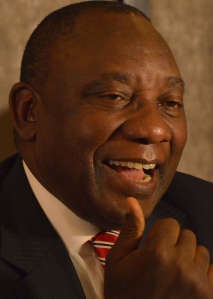
Cyril Ramaphosa had reason to smile after brokering peace deal in Lesotho. But will it last? (Photo: mjj)
Maseru (Lesotho) (AFP) – Lesotho’s feuding political parties have agreed to hold elections in February — more than two years early — in a bid to exit a crisis that has seen a coup attempt and running battles between the security forces.
“National general elections will be held towards the end of February 2015,” said mediator and South African Deputy President Cyril Ramaphosa.
The exact date for the polls, originally set for 2017, will be set by King Letsie III, he added.
Just two years ago, Lesotho was hailed as a beacon of democracy in southern Africa, carrying out a peaceful handover of power, then forming one of Africa’s rare coalition governments.
But that disintegrated amid constant bickering, corruption allegations, political violence and an August 30 attempted coup.
Thursday’s agreement will also see parliament reconvene on October 17 after being shuttered by Prime Minister Tom Thabane in June as he looked poised to lose a no-confidence vote.
Posted in "From East to East" | Tagged Coalition Government, Commonwealth of Nations, Constitution, Elections, LDF, Lesotho Defence Force, Lesotho Mounted Police Service, LMPS, Lt. Gen. Tlali Kamoli, Mediator Cyril Ramaphosa, Military Commander Tlali Kamoli, Prime Minister Tom Thabane, Rajendra Prasad, SADC, South African Deputy President Cyril Ramaphosa, Southern African Development Community | Leave a Comment »
(The following article was published Oct. 1 by international news agency AFP.)
Posted in "From East to East" | Tagged Deputy President Cyril Ramaphosa, Deputy Prime Minister Mothetjoa Metsing, LDF, Lesotho Coup, Lesotho Crisis, Lesotho Defence Force, Lesotho Mounted Police Service, LMPS, Lt. Gen. Tlali Kamoli, Military Commander Tlali Kamoli, Moahloli Mphaka, Prime Minister Tom Thabane, SADC, SADC Observers, Shootout, South Africa, South African Police, Southern African Development Community, Tumisang Mosotho | Leave a Comment »
(The following article was published Sept. 29 by international news agency AFP.)
Posted in "From East to East" | Leave a Comment »
(The following piece was published Sept. 28 in Lesotho’s Sunday Express. A shorter version was first published Sept. 25 by international news agency AFP.)
By Michael J. Jordan
MASERU – Four weeks on, the crisis deepens. Day by day.
Political deadlock. A shootout between Lesotho police and military. Two Lesotho Times journalists arrested for “provoking the peace.” Threats of angry protest in the streets. And the “renegade” military commander still refuses to surrender.
Enter, the outsiders.
In the wake of South African President Jacob Zuma’s visit to Lesotho on Sept. 9, Deputy President Cyril Ramaphosa this week finished his second stint in shuttle-mediation between Pretoria and Maseru. He’s expected back soon for his third.
More dramatically, this week also saw the arrival of Namibian, Zimbabwean and other police officers from across the Southern African Development Community – to serve as “observers,” for at least three months.
For Basotho, the blow to national pride compounds the anxiety of insecurity. And after watching his people struggle to solve their own problems, one member of the Basotho royal family is now offering a solution: empower the King.
Remove the constitutional “straightjacket” that binds King Letsie III, says his younger brother, Prince Seeiso Bereng Seeiso.
“Where are we as a nation, that whenever we have a political fall-out, we always need foreign intervention,” Prince Seeiso said in an interview this week. “Let’s step back and ask: ‘Are there any internal mechanisms, or voices of reason, amongst us?’ Yes, there is someone among us who can step into that role to mediate: His Majesty.”
It’s a compelling notion in such a heavily politicized atmosphere. Factions all around seem to be hardening, not softening, their positions. Ordinary Basotho today are either impassioned party loyalists, or disappointed in all politicians.
So, to inject this idea of a more muscular constitutional Monarchy into this crisis – as opposed to the other kingdom in southern Africa, Swaziland, where King Mswati III rules as Africa’s last absolute monarch – would surely stir debate.
Posted in "From East to East" | Tagged Basotho Tradition, Chief, Deputy President Cyril Ramaphosa, King Letsie III, Lesotho, Lesotho Constitution, Lesotho Coup, Lesotho Defense Force, Lesotho Independence, Lt. Gen. Tlali Kamoli, Military Commander Tlali Kamoli, Moshoeshoe I, Moshoeshoe II, Pitso, President Jacob Zuma, President Tom Thabane, Pretoria, Prince Seeiso, Prince Seeiso Bereng Seeiso, SADC, SADC Police Observers, South Africa, Southern African Development Community | Leave a Comment »
(The following piece appeared Sept. 25 on the international news agency, AFP. A much longer version was published Sept. 28 in Lesotho’s Sunday Express.)
Posted in "From East to East" | Tagged Basotho King, Constitution, Deputy President Cyril Ramaphosa, Foreign Intervention, King Letsie III, LDF, Lesotho, Lesotho Coup, Lesotho Defense Force, Lesotho Mounted Police Service, Lesotho's Independence, LMPS, Moshoeshoe I, Moshoeshoe II, Namibian Police, President Jacob Zuma, Prime Minister Tom Thabane, Prince Seeiso, Prince Seeiso Bereng Seeiso, SADC, SADC Observers, South Africa, Southern African Development Community | Leave a Comment »
(The following piece was published Sept. 21 by AFP/Agence France-Presse.)
Posted in "From East to East" | Tagged Attempted Military Coup, Aug. 30, Democratic Congress, Lesotho Coup, Lesotho Defence Force, Lesotho Mounted Police Service, Lt. Gen. Tlali Kamoli, Military Commander Tlali Kamoli, Mokheseng Ramahloko, Police Chief Khothatso Tsooana, Police Commissioner Khothatso Tsooana, Prime Minister Pakalitha Mosisili, Prime Minister Tom Thabane, SADC, Southern African Development Community | Leave a Comment »
(The following piece was published Sept. 19 by AFP/Agence France-Presse.)
Posted in "From East to East" | Tagged Amensty, Impunity, Injustice, Lesotho, Lesotho Coup, Lesotho President Thomas Thabane, Lieutenant General Maaparankoe Mahao, Lieutenant General Tlali Kamoli, Lt. Gen. Tlali Kamoli, Maseru Police District Commissioner Mofokeng Kolo, Military Commander Tlali Kamoli, Mutiny, police commander Khothatso Tsooana, SADC, South Africa, South African President Jacob Zuma, Southern African Development Community, Sub-Inspector Mokheseng Ramahloko, Treason | Leave a Comment »
(The following photo-essay was published Sept. 18 in New York – on The Mantle.)
Photos and Text by Michael J. Jordan (Soon to be posted here!)
Posted in "From East to East" | Leave a Comment »
(The following piece was published Sept. 16 by AFP, the French news agency.)
Lesotho may head to the polls soon in an attempt to restore political stability, as the country’s leadership crisis appears to be intensifying.
by Stephanie Findlay with Michael J. Jordan in Maseru
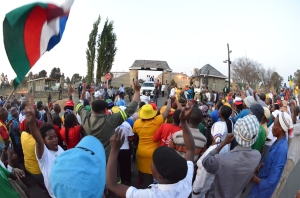
Hundreds cheer returning Lesotho Prime Minister Tom Thabane outside his official residence on Sept. 16. But what was there to cheer? Thabane himself looked glum. No smile, no wave. (Photo: mjj)
PRETORIA, September 15, 2014 (AFP) – Lesotho’s leaders plan to head to the polls early to restore political order following stalled peace talks between deadlocked political parties.
As a result of the coalition government not being “fully functional”, Lesotho’s leaders are planning to “shorten the mandate of the coalition,” said South Africa’s Minister of International Relations and Co-operation Maite Nkoana-Mashabane on Monday.
Lesotho is currently due to hold elections in 2017. The country should now focus on “free, fair and incident free democratic elections for a fresh mandate,” said Nkoana-Mashabane.
After weeks of failed talks, South Africa hosted an emergency meeting of regional leaders to negotiate a peace deal for Lesotho.
South African President Jacob Zuma and Zimbabwean President Robert Mugabe, chairperson of the 15-member Southern African Development Community (SADC), sat down with Lesotho’s leaders to hash out a solution after rival party leaders failed to patch up their differences.
Along with the early election date – to be announced “as soon as possible,” according to Nkoana-Mashabane – SADC said it will send an observation mission, led by South Africa and including Zimbabwe, to Lesotho for three months to ensure peace and stability.
“Are we deploying soldiers to Lesotho or Kingdom of Lesotho as SADC? The answer is, ‘No’,” said Nkoana-Mashabane. “They need to go back to the electorate,” said the minister, “but they need to be assisted so that political challenges don’t get mixed up with the security challenges.”
Posted in "From East to East" | Tagged Attempted Military Coup, Democratic Congress, Lesotho, Lesotho Coup, Lesotho Elections, Lt. Gen. Tlali Kamoli, Pakalitha Mosisili, President Jacob Zuma, Prime Minister Thomas Thabane, Robert Mugabe, SADC, South Africa, Southern African Development Community, Zimbabwe | 1 Comment »
(The following piece was published globally on Sept. 12 by Xinhua, the Chinese news agency. It appeared in Namibia, for example.)
News Analysis: Amid Lesotho’s political crisis, no easy solutions
By Michael J. Jordan
MASERU, Lesotho Sept. 12 (Xinhua) — Two weeks into a political crisis in Lesotho that threatens to erupt in civil strife between party supporters, observers agree that any resolution would have repercussions for this tiny African nation.
South African President Jacob Zuma, whose country fully encircles Lesotho, had visited the mountain enclave Tuesday, to mediate among political leaders and resolve what has become a parliamentary and military standoff.
On Friday, Zuma, representing both South Africa, the regional power, and the 15-member Southern African Development Community (SADC), for whom this is another test in conflict resolution – was expecting Lesotho’s tripartite coalition government to remove a key stumbling-block to peace: a concrete date to re-open Parliament, which Prime Minister Thomas Thabane suspended in June.
SADC leaders will meet Monday in Pretoria to discuss the Lesotho crisis.
For Thabane, though, re-opening Parliament may be political suicide. As he did in June, Thabane would likely face an immediate vote of no-confidence, and loss of his premiership. Or, he could call for new elections for the 1.8 million Basotho.
Meanwhile, a second issue, which rattles regional security, also remains unresolved: what to do about the “renegade” military commander, Lt. Gen. Tlali Kamoli. He is reportedly heavily armed, protected by loyalists, and refuses to accept his Aug. 29 firing by Thabane.
The country is at a historical turn which just two years ago was a beacon of democratic progress in southern Africa.
Posted in "From East to East" | Tagged Deputy Prime Minister Mothetjoa Metsing, Lesotho Coup, President Jacob Zuma, Prime Minister Thomas Thabane, SADC, Southern African Development Community, Tlali Kamoli | Leave a Comment »
(The following piece was published globally Sept. 12 by Agence France-Presse.)
South Africa will convene regional leaders Monday after they failed to resolve a Lesotho crisis sparked two weeks ago by an aborted coup.
By Michael J. Jordan
MASERU (AFP) – Lesotho’s deadlocked political parties failed to meet a Friday deadline for a fresh peace deal, prompting South Africa to call an emergency meeting of regional leaders.
After promising President Jacob Zuma they would decide by Friday when to re-open Lesotho’s Parliament, rival leaders failed to resolve a crisis sparked two weeks ago by an aborted coup. Reopening the legislature – which was shuttered in June – is seen as a key step toward restoring normality in the tiny mountainous state.
On Aug. 30, an attempted coup by renegade general Tlali Kamoli saw the military assault several police stations prompting the prime minister to flee the country. One Lesotho police officer was killed, and nine others injured in the unrest.
Prime Minister Tom Thabane has since returned, protected by South African guards, but a Pretoria-brokered peace deal quickly disintegrated. On Friday rival party leaders failed to patch up their difference, instead calling for the 15-member Southern African Development Community (SADC) to step in.
“How can you open your own Parliament when you still have foreign troops here, protecting you?” asked Thesele Maseribane, one of those who fled and is now under foreign guard. “Everyone’s interested in Parliament, but what about what recently happened here? This is not a movie. This is reality. This was an attempted coup.”
Deputy Prime Minister Mothetjoa Metsing’s Lesotho Congress for Democracy (LCD) party has been blamed along with Kamoli for the putsch. Kamoli has refused a prime ministerial order to resign and has apparently raided government armouries in preparation for a showdown.
His allies have warned of a “bloodbath” if he is forcibly removed.
Posted in "From East to East" | Tagged 1998 Intervention, Bloodbath, Democratic Congress, Incitement, Joang Molapo, Lesotho Coup, Military Coup, Mothetjoa Metsing, Political Violence, President Jacob Zuma, Prime Minister Thomas Thabane, Rule of Law, SADC, Southern African Development Community, Thesele Maseribane, Tlali Kamoli | Leave a Comment »
(The following article appeared Sept. 10, 2014, in the French news agency, AFP.)
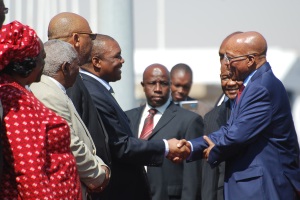
Jacob Zuma (right) arrives at the Lesotho airport and greets the man seen as main instigator of the country’s crisis, Deputy Prime Minister Metsing. Prime Minister Thomas Thabane looks on, smiling from Zuma’s right. (Photo: mjj)
By Michael J. Jordan
Maseru, Lesotho (AFP) – Rival Lesotho leaders vowed to resolve an 11-day crisis that has spurred calls for regional military intervention in the tiny African nation, after South Africa brokered talks.
The sparring factions agreed to hold further negotiations and present a concrete date for reopening Lesotho’s parliament to South Africa’s President Jacob Zuma on Friday.
“We had very frank and good kind of discussions,” said Zuma Tuesday after the three-hour meeting, aimed at keeping a week-old peace deal alive.
“We’re just about to get there,” said Lesotho Prime Minister Thomas Thabane, who suspended parliament in June and has struggled to preserve his coalition government — a rarity in African politics.
But the parties remained silent on how to tackle the “renegade” Lesotho military commander Lieutenant General Tlali Kamoli, who is accused of triggering the crisis on August 30, one day after he was fired by Thabane.
Posted in "From East to East" | Tagged 1998 SADC Intervention, Jacob Zuma, Lesotho, Lesotho Coup, Mothetjoa Metsing, Pakalitha Mosisili, South Africa, Southern African Development Community, Thomas Thabane, Tlali Kamoli | 1 Comment »
(The following article appeared Sept. 2, 2014, in The Christian Science Monitor.)
Just two years ago Lesotho was referred to as a democratic success story in Africa. But its attempted coup presents a test for the Southern African Development Community, committed to peace in the region.
MASERU, Lesotho — Two years ago, this tiny nation high in the mountains of southern Africa earned acclaim for passing the latest test of African democracy: It pulled off the region’s first peaceful handover of power. Lesotho then went one step further, forming what some call the first and only coalition government in all of Africa.
This week, however, these claims to democratic fame have been put to the test. An attempted military coup early Saturday sent Prime Minister Thomas Thabane scampering into South Africa – and the entire police force into hiding. A power vacuum still persists after four days.
“It’s a test of one of Africa’s democratic ‘success stories,’” says the United Nations’ resident coordinator in Lesotho, Karla Hershey.
But the attempted coup goes beyond Lesotho, presenting a major challenge for the Southern African Development Community, the 15-member union committed to “peaceful settlement of disputes.” SADC has been burned by Lesotho before, and has been hesitant to take decisive action after this weekend’s attempted coup.
Posted in "From East to East" | Leave a Comment »
(The following commentary was published on July 28th by GlobalPost. A longer version was earlier published by The Lesotho Times and The Mantle in New York.)
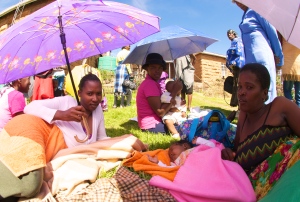
Basotho women await immunizations for their infants outside a sunny, rural health clinic. (Photo: mjj)
MASERU, Lesotho – Some rankings instill pride. Others instill shame, and should inspire every effort to get off that list.
Two years ago, in a report for GlobalPost, I described how tiny Lesotho, a landlocked country high in the mountains of southern Africa, achieved a first for the entire region: a peaceful handover of power from ruler to opposition.
Two years later, the Basotho people of Lesotho have quietly climbed the wrong list. UNAIDS, reporting the “hope that ending AIDS is possible,” now ranks Lesotho as suffering the world’s second-highest rate of HIV infection; at 23 percent, the tragedy has touched nearly every Basotho family.
The rate of Lesotho’s HIV affliction hasn’t changed in a decade. The country, under a fragile coalition government, has become a case study for the limits of international development assistance, and a cautionary tale for what happens when a country is reluctant to tackle the real issues that plague ordinary people.
The Basotho resist the need to confront the broader health crisis that makes their country, by nearly every health indicator, one of the world’s sickliest.
Posted in "Christian Science Monitor", "Global Post" | Tagged African Health, Basotho Mothers, Basotho Women, Botswana, Foreign Aid, Global Health, Health Journalism, HIV Epidemic, HIV/AIDS, International Development Assistance, Jhpiego, PEPFAR, Rate of HIV Infection, World Health Organization | 4 Comments »
(The following commentary was published on July 24th in Lesotho, in The Lesotho Times. It was originally published in New York, on July 15th, on The Mantle.)
MASERU, Lesotho – Lesotho, a mini-model of African democracy!
That’s what I trumpeted two years ago, when reporting the great political achievement scored by the ethnic Basotho of Lesotho.
In the latest test of democracy in Africa, Basotho political elites produced their first elections without violence, then carried out a peaceful handover of power – a first for southern Africa.
Today, though, this beacon of democracy flickers dimly. Amid the jockeying for power, some whisper of a coup. Even South Africa – which surrounds “The Mountain Kingdom” and sent in soldiers before – warned Lesotho to cool tensions.
Yet all this gamesmanship obscures the real crisis: in Basotho health. Indeed, while the politicians fiddle, Rome burns. (Or in Lesotho, while Roma burns.)
The 1.8 million souls who dwell in Lesotho rank, by virtually every health indicator, among the sickliest on the entire planet. Moreover, Lesotho has become a case-study for the limits of international development assistance – and a cautionary tale for what happens when a nation is reluctant to tackle the real issues that plague ordinary people.
For starters, Lesotho suffers an HIV infection-rate of 23 percent, a tragedy that has touched and traumatized every Basotho family. I’ve seen this first-hand, while preaching the virtues of Health Journalism here for two years. All along, I’ve cited Lesotho as enduring “the world’s third-highest rate” of HIV infection – among those within the most sexually active ages: 15 to 49 years old.
But while Basotho lawmakers play politics, Lesotho quietly achieved a bit of notoriety: the UN agency, UNAIDS, elevated Lesotho from third to second place. (Behind only Swaziland, our neighborhood’s other mountain kingdom.)
Curiously, Lesotho’s new ranking is not because the infection rate has risen.
Posted in "Christian Science Monitor", "From East to East" | Tagged African Health Journalists Association, Basotho Nation, Botswana, Democracy in Africa, Democracy in Lesotho, Development Journalism, Health Journalism, HIV in Lesotho, HIV/AIDS, ICAP-Columbia, International Center For Journalists, International Development Assistance, Internews, King Letsie III, Malnutrition, Mother-to-Child Transmssion of HIV, PEPFAR, Sexual Health, Stigmatization, Stunting, Swaziland, Taboos, UNAIDS, UNICEF, United Nations, Voluntary Medical Male Circumcision, World Health Organization | Leave a Comment »
(This is Part I of my six-part travelogue from shooting our documentary film, The Clubhouse: A Post-Apartheid Story. It was published in New York on July 22, on The Mantle. To join our team, please visit our Indiegogo site. For more travelogue, here’s Part II, Part III, Part IV, Part V & Part VI.)
VENTERSDORP, South Africa – Heading into this road-trip to shoot our documentary film on South Africa’s “most racist town,” I have one nagging fear.
And the drumbeat will grow louder as the weekend progresses.
My worry is not whether we’ll capture enough compelling scenes and “beauty shots” to bring The Clubhouse: A Post-Apartheid Story to life. (We will, as you’ll soon see in our new trailer.) Or, if I can press our soft-spoken hero, Samuel – the first black golfer to kick down the door of the all-white Golf Club in notorious Ventersdorp – to expose more of his psyche, and enable our audience to actually care about his heroic journey from dehumanized caddy to card-carrying member of the club. (He will, and then some.)
Instead, I fret over our film’s content: “racial healing and equal opportunity” in post-Apartheid South Africa. If not explored deeply enough, it may damage my reputation. For being too positive. Or in media parlance: “a puff-piece.”
After all, we’re talking about Ventersdorp – home of Eugene Terre’Blanche and his violent AWB movement. Three loyalists even fought to the death, defending Apartheid. So from this town, which even some local whites are still ashamed to call their own, our film will show smiling white golfers glad-handing black golfers?
For the first three-quarters of our weekend in Ventersdorp, during which we’re filming the 2014 Golf Club Championship, we shoot plenty of smiles and glad-handing of Samuel and his buddy, Monte, who joined him on his 15-year crusade to crack the Club’s color-barrier.
“We need to find an older member here who’s not happy with this situation,” I tell my South African partner, Danny Lurie. “We gotta get their voice in the film.”
Danny, weighing the wrath of his compatriots, agrees.
“Yeah, or the South African media may tear us apart, too.”
We journalists are often criticized for focusing on the negative, for ignoring the positive. Now we’re desperate to do the opposite: dig up dissent.
Posted in "Clubhouse: A Post-Apartheid Story" | Tagged Afrikaner Resistance Movement, ANC, ANC-Dominated, Apartheid Era, Apartheid Regime, AWB, Black Caddies, Black golfers, Black majority, Black South Africans, Black-White Relations, Democracy, Democracy in Africa, Equal Opportunity, Eugene Terre'Blanche, Farmer Killings, Golf, Golf during Apartheid, Inter-Racial Relations, Most Racist Town, Nelson Mandela, Post-Apartheid, Post-Apartheid South Africa, Racial Healing, South Africa, South African Farmers Killed, The Battle of Ventersdorp, The New South Africa, The Rainbow Nation, Ventersdorp, Ventersdorp Golf Club, White minority, White Rule, White South Africans, White Supremacy | 1 Comment »
(This is Part VI of my six-part travelogue from shooting our documentary film, The Clubhouse: A Post-Apartheid Story. To join our team, please visit our Indiegogo site. For more travelogue, here’s Part I, Part II, Part III, Part IV & Part V.)
VENTERSDORP, South Africa – I thank Derrick for his time, with sincere gratitude.
Getting him to say as much as he just did is a minor coup.
Honestly, I don’t know if Derrick was already planning to clear the air with Samuel – and even apologize. Or, after I presented him a noble path forward, he pounced on it like a life-preserver. Have I shaped the story? Time will tell. But if my outsider-influence nurtures progress, I can live with that consequence. (Could you?)
Moreover, it now dawns on me. Not only is The Clubhouse drilling deeper into the core of inter-communal relations within this one infamous farming town – and extracting some illuminating evidence of racial healing and black empowerment.
Now, thanks to Derrick’s angry slip of the tongue, we have a cliff-hanger, too.
Will they? … Or won’t they?
Will the Golf Club investigate the incident? And mete out tough punishment?
Will Derrick offer an apology? Will he do so willingly? Or unwillingly?
Even then, will Sam accept it? Will he be placated by how Club leaders deal with this nasty episode? Or, disgruntled, will he make good on his threat – and quit?
Likewise, if Charles is disappointed by his colleagues’ verdict, will he also quit?
Posted in "Clubhouse: A Post-Apartheid Story" | Tagged Afrikaner Resistance Movement, ANC, ANC-Dominated, Apartheid Era, Apartheid Regime, AWB, Black Caddies, Black golfers, Black majority, Black South Africans, Black-White Relations, Democracy, Democracy in Africa, Equal Opportunity, Eugene Terre'Blanche, Farmer Killings, Golf, Golf during Apartheid, Inter-Racial Relations, Most Racist Town, Nelson Mandela, Post-Apartheid, Post-Apartheid South Africa, Racial Healing, South Africa, South African Farmers Killed, The Battle of Ventersdorp, The New South Africa, The Rainbow Nation, Ventersdorp, Ventersdorp Golf Club, White minority, White Rule, White South Africans, White Supremacy | Leave a Comment »
(This is Part V of my six-part travelogue from shooting our documentary film, The Clubhouse: A Post-Apartheid Story. To join our team, please visit our Indiegogo site. For more travelogue, here’s Part I, Part II, Part III, Part IV & Part VI.)
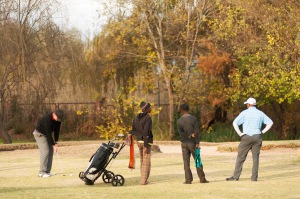
Race relations in The Rainbow Nation: progress is two putts forward, one putt back. (Photo: Justin Keane)
VENTERSDORP, South Africa – It’s not hard to figure out which golfer bellowed that dreaded insult, kaffir.
This fellow, Derrick, had already sent our crew a negative vibe, standing out from the friendlier folks with his gruffness. I hadn’t yet met him, but now need to confront him, respectfully: Why’d you use that word? And what will you do now?
I ask around at the Club for his phone number, explaining that I want to give Derrick a fair chance to explain his actions. Defend himself. Maybe, express remorse.
I don’t look forward to a combative call, though I prefer it to a gotcha-journalism that might force me to drive out to his farm. Where he may slam a door in my face. Or, greet me by the barbwire with snarling dogs and loaded shotgun. It’s a possibility, in a town that’s seen several white farmers killed in recent years.
Finally, on Tuesday morning, I get around to calling Derrick – 36 hours after the Sunday-afternoon incident. Minimally, I want reaction. Even a raging No comment! and abrupt hang-up is still a comment. It speaks volumes, no less.
Fortunately, my cameraman is a seasoned hand. He suggests, brilliantly: If you’re going to call him, let’s get the mic on you, put him on speaker – and film it.
(We’ll eventually stream this and other interviews on our website for The Clubhouse: A Post-Apartheid Story, preserving it as if in a time-capsule.)
As the phone rings for Derrick, my heart beats faster. A touch of anxiety. I need this potentially reluctant source to talk – and say something of real value.
And boy, does Derrick talk. Although, not at first.
Posted in "Clubhouse: A Post-Apartheid Story" | Tagged Afrikaner Resistance Movement, ANC, ANC-Dominated, Apartheid Era, Apartheid Regime, AWB, Black Caddies, Black golfers, Black majority, Black South Africans, Black-White Relations, Democracy, Democracy in Africa, Equal Opportunity, Eugene Terre'Blanche, Farmer Killings, Golf, Golf during Apartheid, Inter-Racial Relations, Most Racist Town, Nelson Mandela, Post-Apartheid, Post-Apartheid South Africa, Racial Healing, South Africa, South African Farmers Killed, The Battle of Ventersdorp, The New South Africa, The Rainbow Nation, Ventersdorp, Ventersdorp Golf Club, White minority, White Rule, White South Africans, White Supremacy | 1 Comment »
(This is Part IV of my six-part travelogue from shooting our documentary film, The Clubhouse: A Post-Apartheid Story. To join our team, please visit our Indiegogo site. For more travelogue, here’s Part I, Part II, Part III, Part V & Part VI.)
VENTERSDORP, South Africa – Facing a fork in the road, white leaders of the Ventersdorp Golf Club beat their chests in despair and howled to the heavens.
“How can we denounce one of our own,” they wailed, “for cursing blacks the same way everyone did – and was completely normal – just 20 years ago?”
Ok, that’s probably not what’s unfolding inside The Clubhouse. Maybe there is no crisis of conscience. Maybe they sensed, instinctively, their course of action. I’ll never know. Because I’m outside, waiting on the terrace, pondering.
If they handle it well, then … Or, if they handle it poorly, then …
The conclusion’s the same, though. Either way, no matter what path they choose, our story is infinitely better. It’ll be much richer in texture.
What will surprise me, though, is how Club leaders will vow to take action.
One leader, at least. With a bold gesture.
Posted in "Clubhouse: A Post-Apartheid Story" | Tagged Afrikaner Resistance Movement, ANC, ANC-Dominated, Apartheid Era, Apartheid Regime, AWB, Black Caddies, Black golfers, Black majority, Black South Africans, Black-White Relations, Democracy, Democracy in Africa, Equal Opportunity, Eugene Terre'Blanche, Farmer Killings, Golf, Golf during Apartheid, Inter-Racial Relations, Most Racist Town, Nelson Mandela, Post-Apartheid, Post-Apartheid South Africa, Racial Healing, South Africa, South African Farmers Killed, The Battle of Ventersdorp, The New South Africa, The Rainbow Nation, Ventersdorp, Ventersdorp Golf Club, White minority, White Rule, White South Africans, White Supremacy | 1 Comment »
(This is Part III of my six-part travelogue from shooting our documentary film, The Clubhouse: A Post-Apartheid Story. To join our team, please visit our Indiegogo site. For more travelogue, here’s Part I, Part II, Part IV, Part V & Part VI.)
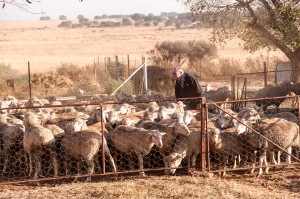
Allan Jones is no ordinary South African sheep-farmer. He’s also helped lead a flock of golfers toward racial equality. (Photo: Justin Keane)
VENTERSDORP, South Africa – In 2009, Allan Jones, a successful sheep farmer and progressive town councilman, was elected President of the Ventersdorp Golf Club.
And as The Clubhouse describes, Allan is also the local mover-and-shaker who would soon play the pivotal role in steering the whites-only Club to finally admit Sam and Monte as their first black members. A mere 15 years after Apartheid.
Allan seems an unlikely revolutionary – until you learn his back-story. During Apartheid, though he enjoyed the privilege of white skin, he also felt “marginalized” amid the white reign over the black majority. Reared in this heartland of Afrikaans-speaking Boers, who trace their roots to the hardy voortrekker pioneers of the 19th century, Allan instead descends from “the English” who later settled in the region.
Meanwhile, unlike the conservative Boers, Allan belongs to the Methodist church: one of the few places during Apartheid where blacks and whites sat as equals.
Fortunately for me, Allan was one of the first people I met in Ventersdorp, during my initial visit in April 2013. I’d read that he was the only white on the black-dominated Town Council, so wanted to ask how life had been flipped upside-down. It was Allan who sparked my idea for this film, by casually noting, “So much has changed, that our Club now has not one, but even two, black members.”
He bought into The Clubhouse – and cleared with Club leaders our full access to the golf championship. So at this moment, with us reacting to a dramatic twist to our story, it’s Allan I seek out. Again, to grease the wheels of Club cooperation.
Posted in "Clubhouse: A Post-Apartheid Story" | Tagged Afrikaner Resistance Movement, ANC, ANC-Dominated, Apartheid Era, Apartheid Regime, AWB, Black Caddies, Black golfers, Black majority, Black South Africans, Black-White Relations, Democracy, Democracy in Africa, Equal Opportunity, Eugene Terre'Blanche, Farmer Killings, Golf, Golf during Apartheid, Inter-Racial Relations, Most Racist Town, Nelson Mandela, Post-Apartheid, Post-Apartheid South Africa, Racial Healing, South Africa, South African Farmers Killed, The Battle of Ventersdorp, The New South Africa, The Rainbow Nation, Ventersdorp, Ventersdorp Golf Club, White minority, White Rule, White South Africans, White Supremacy | Leave a Comment »
(This is Part II of my six-part travelogue from shooting our documentary film, The Clubhouse: A Post-Apartheid Story. To join our team, please visit our Indiegogo site. For more travelogue, here’s Part I, Part III, Part IV, Part V & Part VI.)
VENTERSDORP, South Africa – As we race back to the Golf Club, my mind churns with strategies and tactics for how to “cover” this story.
The white leadership granted us unfettered access to the course, the clubhouse, and the championship itself – trusting our intent to highlight actual positive progress in their infamous hometown. Yet now a K-word grenade has exploded in their faces.
For a white to spew kaffir at a black in “The Rainbow Nation,” twenty years after Apartheid – well, those are fighting words. Or worse. On the golf course, no less?
Yet it’s now past 5 in the afternoon, the golf tournament is winding down, and our natural light is dissolving. But here we are, car-bound, our crew and gear rattling over the ever-present potholes of provincial South Africa.
A few streets from the Club, we spot two of the black caddies, done for the day, walking along the road. Screeching to a stop, we bounce out and switch on the camera.
Both caddies are about 40, though their weather-beaten faces made them look much older. They began caddying in their early teens – during Apartheid, just like our black golfer-heroes, Samuel and Monte. However, while those two are now full-fledged members of the Club – and solidly middle-class – these two fellows are still just caddies. Hovering near the bottom rung of society. Their skin color no longer keeps them out of The Clubhouse; only their empty pockets do.
In a mix of English, Afrikaans and their native Setswana, they describe what happened on the course, expressing anguish that it’s been a “very long time” since they last heard the k-word – and spit with such venom.
“It was very painful for me,” recounts Henrik Petersen, who heard it up close. “I was feeling to fight, but it’s not right … As people, we must live together. That’s the way it is. He must respect us – as we must respect him.”
Fellow caddy Phillip Mazwi goes further, demanding justice.
“We are busy trying to build up, and this takes us back – to the Apartheid,” says Mazwi. “It’s discrimination. And they must take that whitey to the police station and open a case: for defamation of character.”
Defamation? I jot it in my journal. Even a caddy in The New South Africa now recognizes hate-speech when he hears it – and calls for legal action against it? (More evidence, I note, of how far the country has come.)
As we park back at the Club, I tell my cameraman: Keep the camera rolling.
Posted in "Clubhouse: A Post-Apartheid Story" | Tagged Afrikaner Resistance Movement, ANC, ANC-Dominated, Apartheid Era, Apartheid Regime, AWB, Black Caddies, Black golfers, Black majority, Black South Africans, Black-White Relations, Democracy, Democracy in Africa, Equal Opportunity, Eugene Terre'Blanche, Farmer Killings, Golf, Golf during Apartheid, Inter-Racial Relations, Most Racist Town, Nelson Mandela, Post-Apartheid, Post-Apartheid South Africa, Racial Healing, South Africa, South African Farmers Killed, The Battle of Ventersdorp, The New South Africa, The Rainbow Nation, Ventersdorp, Ventersdorp Golf Club, White minority, White Rule, White South Africans, White Supremacy | Leave a Comment »
VENTERSDORP, South Africa – It’s late in the day, and we’re losing daylight. My documentary-film partner is leading one camera crew, while I lead our second.
My phone rings, as I’m driving.
“There’s been a development,” says Danny, soberly. My mind flashes to the top-shelf Sony we’re renting for a small fortune, per day. “Come quick!”
After 20 years as a foreign correspondent, it’d take a lot to rattle me. In fact, I love the challenge of adapting, of switching gears, under pressure. Especially when you’re on the ground, when time is precious – indeed, when time is money.
One thing I’m learning from documentary film, just as I’ve learned over the years from “parachute” reporting into 30 countries: not even a well-hatched plan goes according to plan. So when the inevitable crisis strikes, how do you handle it?
No, you don’t panic and throw in the towel – You’re a professional, dammit! Your reputation is at stake. Even the university student or young journalist who’s serving as your interpreter is watching you, studying your response.
So, you breathe deep, soothe the voices in your head, collect the facts, assess the situation. Will you shift into salvage-mode? Or, take the steps that produce an even better story? As we Americans put it, “When dealt lemons, make lemonade.”
The range of crises is vast.
Posted in "Clubhouse: A Post-Apartheid Story" | Tagged Afrikaner Resistance Movement, ANC, ANC-Dominated, Apartheid Era, Apartheid Regime, AWB, Black Caddies, Black golfers, Black majority, Black South Africans, Black-White Relations, Democracy, Democracy in Africa, Equal Opportunity, Eugene Terre'Blanche, Farmer Killings, Golf, Golf during Apartheid, Inter-Racial Relations, Most Racist Town, Nelson Mandela, Post-Apartheid, Post-Apartheid South Africa, Racial Healing, South Africa, South African Farmers Killed, The Battle of Ventersdorp, The New South Africa, The Rainbow Nation, Ventersdorp, Ventersdorp Golf Club, White minority, White Rule, White South Africans, White Supremacy | Leave a Comment »
(For more on The Clubhouse and the notorious farming town at the heart of our story, read my article here. It was originally published on the New York-based website, The Mantle. To join our team, please visit our Indiegogo site.)
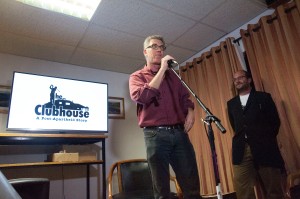
As Danny looks on, I unveil our trailer to a crowd of well-wishers … and donors. (Photo: Justin Keane)
MASERU, Lesotho – We spread the word. You answered the call. And then some!
At our fundraising launch-party in Maseru last night, Danny and I were overwhelmed by the outpouring of support for our documentary film – and touched by the generosity of The International Community of Lesotho. More than 12,000 maloti (US$1,200) raised. We even sold a bunch of t-shirts and coffee-mugs!
If you couldn’t join us last night, don’t fret: it’s not too late to climb aboard our bandwagon. We’ve just gone LIVE with our online Indiegogo campaign, giving ourselves 60 days to hit our US$10,000 goal. Feel free to check in on our progress!
As promised, I’ve already enshrined all the names of our supporters to date – who’ll forever be linked with the production of The Clubhouse. Please see our second update. And let’s double-check those spellings and institutional affiliations. We want to get it right in the credits of our film!
Meanwhile, we must spotlight those who contributed to our special evening. Three ambassadors were in the house. That’s three-fifths of those resident in Lesotho!
Posted in "Clubhouse: A Post-Apartheid Story" | Tagged Afrikaner Resistance Movement, ANC, ANC-Dominated, Apartheid Era, Apartheid Regime, AWB, Black Caddies, Black golfers, Black majority, Black South Africans, Black-White Relations, Caddies, Democracy, Democracy in Africa, Equal Opportunity, Eugene Terre'Blanche, Farmer Killings in South Africa, Golf, Golf during Apartheid, Inter-Racial Relations, Most Racist Town, Nelson Mandela, Post-Apartheid, Post-Apartheid South Africa, Racial Healing, South Africa, The Battle of Ventersdorp, The New South Africa, The Rainbow Nation, Ventersdorp, Ventersdorp Golf Club, White minority, White Rule, White South Africans | Leave a Comment »
(The following article was published April 27, 2014, on The Mantle. It’s an article spun off the feature-documentary project I’m producing with my partner, The Clubhouse. For more on that film, plus photos, please click here. To join our team, please visit our Indiegogo site.)
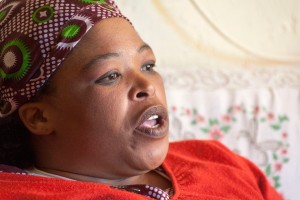
Anna Moabi says she no longer fears for insults or beatings from white farmers. (Photo: Justin Keane)
VENTERSDORP, South Africa – Saturday morning in The New South Africa.
Samuel Phutiagae slips on a green polo and dark khakis, topped by his cherished accessory: a black baseball cap with the TW logo of Tiger Woods – his favorite golfer. In the front yard, his six-year-old daughter, his golfing partner, and their golf bags tumble into his car. Within minutes, Samuel is steering gently onto the grassy parking lot of the Ventersdorp Golf Club itself. Tee-off is at 9.
The scene appears so normal – except that Samuel is no ordinary golfer. He’s a black man in post-Apartheid South Africa. And as the nation marks 20 years since its first democratic elections, on April 27, 1994, the first black member accepted into the all-white Ventersdorp club is something of a revolutionary.
For nearly half a century, South African golf clubs like this were bastions of white elitism, segregation and overlordship. Samuel himself was an impressionable 12-year-old during the tumult of 1980s Apartheid South Africa when he began to caddy at a local golf club, to earn a bit of cash for his family and for himself.
The term “caddy,” though, sounds too polite. The white golfers treated him “like a dog,” he says, and often dropped the most searing of racial insults, the “k-word” – kaffir. When Samuel and other caddies needed drink or food, they knew to march around the clubhouse, to a side window. For blacks, only.
“I used to tell my friends,” he says, “‘One day we’ll be inside this club – playing. You’ll see.’ But they didn’t believe me.”
Posted in "Clubhouse: A Post-Apartheid Story", The Clubhouse | Tagged Afrikaner Resistance Movement, Allan Jones, ANC, ANC-Dominated, Apartheid Era, Apartheid Regime, AWB, Black Caddies, Black golfers, Black majority, Black South Africans, Black-White Relations, Caddies, Danny Lurie, Democracy, Democracy in Africa, Equal Opportunity, Eugene Terre'Blanche, Farmer Killings, Golf, Golf during Apartheid, Inter-Racial Relations, John Kane-Berman, Most Racist Town, Nelson Mandela, Post-Apartheid, Post-Apartheid South Africa, Racial Healing, Racism, South Africa, South African Farmers Killed, South African Institute on Race Relations, The Battle of Ventersdorp, The New South Africa, The Rainbow Nation, Ventersdorp, Ventersdorp Golf Club, White minority, White Rule, White South Africans, White Supremacy | 1 Comment »
(The following text, trailer and photos will soon appear on the crowdfunding platform, Indiegogo, as my partner and I launch an online campaign to raise US$10,000 for our feature documentary, The Clubhouse. In post-Apartheid South Africa’s most racist town, our film explores how one Golf Club finally admitted a black man – and opened the door to racial healing.)
Our Project
April 27, 1994. A day that produced one of the seismic events of the 20th Century.
Nelson Mandela and the euphoric first democratic elections in South Africa – which snuffed out one of the world’s most racist and despised regimes: Apartheid. Overnight, voters handed power to the long-suffering black majority – and in a flash, reduced their white overlords to a vulnerable minority.
Today, exactly twenty years later, how can we gauge, and even illuminate, the depth of racial healing in The Rainbow Nation? This documentary provides compelling evidence. To tell the story, I went to South Africa’s most racist town, where I found one ordinary black man. Who’s done something extraordinary.
I’m an American foreign correspondent who has reported from 30 countries over the past 20 years, mostly across post-Communist East Europe and the former Soviet Union. I now live high in the mountains of Southern Africa, where I’ve teamed up with a South African filmmaker-activist, Danny Lurie, on a unique film project.
Thank you for taking the time to visit our Indiegogo campaign, to learn about the feature documentary that we’re making down here: The Clubhouse: One Black Golfer’s Fight for Equality in South Africa’s Most Racist Town.
Please watch our trailer, as we chronicle the heroic journey of one black man, from one notorious farming town, as he chases a seemingly simple dream: to play golf. The only course in town, though, belongs to the stubbornly, whites-only Golf Club. And the Club’s decision to finally relent and allow him to play their course speaks volumes about how far the white minority has come along, too.
“It was the right thing to do,” explains Club President Jacques Viviers. “And many of us knew it.”
Posted in "From East to East", The Clubhouse | Tagged AWB, Black golfers, Black majority, Black townships, Danny Lurie, Documentary Film, Eugene Terre'Blanche, Feature Documentary, Golf, Golf during Apartheid, Herbert Mashishi, Justin Keane, Nelson Mandela, Post-Apartheid, Racism, Segregation, South Africa, South Africa's townships, Sport, The Clubhouse, The New South Africa, The Rainbow Nation, Ventersdorp, Ventersdorp Golf Club, White minority | 2 Comments »
BUDAPEST, Hungary – I’ll never forget my sister’s reaction, when I told her ten years ago of my plan to teach journalism, too. To paraphrase, she wondered: What’s to teach? All reporters need is a pen, pad – and write down what’s happening. Right?
She herself is a family doctor, who’d absorbed a mind-boggling amount of specific material to become one. She wasn’t trying to offend me, or denigrate my craft. Yet her words gave me a greater appreciation for all there is to teach about journalism.
I began to mull more deeply not only how I do what I do, but why exactly I do it this way: from philosophy and psychology to strategies and techniques, in my research, reporting, interviewing and writing. Or, when handling sources, editors and others.
On the flip side – now that I’ve taught students and trained journalists on four continents – I’ve also identified what I cannot teach about journalism. Just three things, really. But they’re biggies, of course: curiosity, empathy and life experience.
Fresh from leading my latest foreign-correspondence training in Prague, I’m reminded why each of the three is also essential to producing the most meaningful, most effective story-telling from faraway lands.
Posted in "From East to East" | Leave a Comment »
[The following piece was published June 3, 2013, on The Mantle.]
MASERU, Lesotho – In November 2011, I was newly arrived in Africa, so full of hope, writing dreamily of Lesotho’s “veritable field of dreams” for journalism trainings.
Eighteen months later, rejection slaps me in the face so often, I’m ready to press charges. I’m a pauper on the streets, banging my tin-cup.
Hey buddy, can you spare a dime? Yes, it’s for a journalism training. But not only will it improve Basotho health, it just may save lives!
I came to Lesotho having taught journalism over the past ten years in New York, Central Europe and Hong Kong – and soon realized I was the only journalism-skills teacher in the entire “Mountain Kingdom.” I studied how to help a tiny nation of 1.8 million, clustered in hamlets among the tallest peaks of southern Africa. Not to teach any kind of journalism, but specifically, health journalism.
The list of what ails the Basotho of Lesotho is depressingly long. They suffer the world’s third-highest rate of HIV infection – an unfathomable 23 percent among the most sexually active, ages 15-49. Malnutrition has hit 40 percent, as two-fifths of the children under age 5 endure stunting of the brain and body. Then there’s TB. Diabetes. Breast cancer. Cervical cancer. And so on. Everywhere you look, bad news.
Meanwhile, it’s darn near impossible to find a decent example of explanatory journalism, to inform and educate society on simply how to cope with all this. Which is unsurprising, since Lesotho lacks any real journalism education or professional training. Among reporters and editors here, “The blind are leading the blind.” (Though, this is not their fault, as I’ve written in a related post.)
Though I’d landed in Africa with no contacts whatsoever – as a dutiful “trailing spouse” following my wife’s career in international development – so optimistic was I about my freelancing prospects that I boldly launched a new feature for my website, and immodestly named it The Media Missionary of Maseru.
Posted in "From East to East", "Mantle", "Nieman Reports", "Transitions Online", Africa, Blogging, Central Europe, China, Eastern Europe, HIV/AIDS, Hong Kong, Hungary, Journalism, Lesotho, Media Missionary of Maseru, Photography, South Africa, Teaching, Writing | Tagged African Health, Basotho, Breast Cancer, Cervical Cancer, Development Journalism, Diabetes, Faculty of Health Sciences, Gender-Based Violence, Global Health, Health Journalism, HKBU, Hong Kong Baptist University, Human Trafficking, International Development Assistance, Internews, Journalism students, Journalism Training, Kenya, Kick4Life, Knight International Journalism Fellowship, Lesotho Media, Malnutrition, MCC, Millennium Challenge Account, Millennium Challenge Corporation, Multiple Concurrent Partners, National University of Lesotho, NUL, PEPFAR, Photos of Basotho, Photos of Lesotho, Population Services International, PSI, Pusha Love, Southern Africa, Student-Journalists, The Health Journalism Club, The Mountain Kingdom, Trailing Spouse, U.S. Embassy of Lesotho, UNICEF, USAID | 1 Comment »
MASERU, Lesotho – A recent article appeared in the Lesotho media with little fanfare, like thousands of health-related articles before it. Yet it fueled my strategy to cultivate journalism education and professional training in Africa’s tiny “Mountain Kingdom.”
As the Lesotho Times article reported, the Ministry of Health unveiled shiny new dormitories for 120 local nurses, pharmacists and lab technicians. The Basotho reporter, presumably with head down, scribbling furiously, noted that speakers thanked the contractor, engineer and U.S. donors. Solar panels made the dorms energy-efficient, while the national water supplier “played a pivotal role … by building a sewer line.”
Nowhere, though, did the reporter illuminate the essential Why: “Why were these dorms built? Why are they so important? Why should readers even care?”
This example illuminates an ongoing pattern in one of Africa’s sickliest countries: the unserious state of media in a society that desperately needs serious and responsible health journalism.
Posted in "From East to East" | Leave a Comment »
[When it comes to freelancing foreign correspondence, no one is more current or savvy than the Indian journalist Mridu Khullar Relph, the 2010 “Development Journalist of the Year.” Mridu is also tireless in educating others about the field through her fine website, produced from her New Delhi home. So, it was my pleasure to answer her questions about how I do what I do. The following interview was first published on her site on Nov. 20, 2012. For more on freelancing, please read my August 2012 piece on how I’d break in today.]
Q&A With Michael J. Jordan, International Journalist
No, not THAT Michael Jordan. Although when it comes to his craft, he’s just as good.
I first “met” Michael online through a friend and was immediately struck by how open he was with his contacts, how helpful and encouraging. Michael and I became part of a small freelancers group that shared tips, editor names, and advice with each other, and when I interviewed Michael for my mailing list, I got such an amazing response, that I knew I had to share it with more readers.
His official bio: Michael J. Jordan is an American freelance foreign correspondent and journalism teacher-trainer now based in Lesotho. Beyond southern Africa, he also maintains a toehold in Asia and Europe, as a Visiting Scholar at Hong Kong Baptist University and as Senior Journalism Trainer for Transitions Online in Prague. He has previously been stationed in Hungary, Slovakia and at the United Nations, as a correspondent for the Christian Science Monitor and many others.
Q. Can you tell me a little bit about yourself and the work that you do?
I’m an American foreign correspondent, journalism teacher-trainer, and freelancing father of three young children. Since November, I’ve lived in tiny Lesotho, in southern Africa, for my wife’s job in international development. Continue Reading »
Posted in "From East to East", "Mantle", "Transitions Online", Africa, Blogging, Central Europe, Hong Kong, Journalism, Media Missionary of Maseru, Teaching, Writing | Tagged "Christian Science Monitor", Foreign Correspondence, Freelance Foreign Correspondent, Freelance Journalist, Freelancer, Freelancing, Hong Kong Baptist University, International Journalism Program, International Reporting, Lesotho, Mridu Khullar Relph, Parachute Reporting, TOL Foreign Correspondent Training Course | 1 Comment »
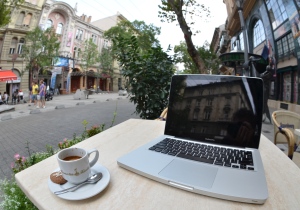
Nagymező utca, the “Broadway of Budapest”: one of countless spots to soak in atmosphere. (Photo: mjj)
[The following piece appeared Sept. 7, 2012, on The Mantle.]
BUDAPEST, Hungary – I’d fallen out of love. This summer, I wanted so badly for that passion to reignite. No, I’m not referring to my marriage, but to the grand old city of Budapest.
Eight weeks later, I’m delighted to report: the embers still smolder. The elegant architecture. The vibrant café culture. The festive night life. Feels like 1997 again!
Budapest is in my blood. I’m a Hungarian-American who launched a career here as a freelance foreign correspondent, back in 1994. I enjoyed the best years of my youth in the city, from age 24 to 30. My father was born here. My wife, too. My three kids spend large doses of time here – and speak the tricky language as well as natives.
Yet the politics of the place have often mortified me, during the two decades of transition from cruel Communist dictatorship to rapacious capitalist democracy. As the atmosphere descended into one of the most noxious in all of Europe, with hatred and depression sucking up oxygen, the capital, too, grew uglier: graffiti scarred the urban landscape; so many shops, boarded and abandoned; pee-stained alcoholics crashed out on benches along once-regal, Habsburgian boulevards.
We now live in Lesotho, in the hardscrabble mountains of southern Africa. In the tiny capital, Maseru, the three or four cafes, three or four restaurants, just don’t compare to Central Europe. As a frigid winter approached, I flew my kids – more an evacuation, really – up to the summer steaminess of Hungary. They’ve spent weeks reconnecting with their grandparents along the family-friendly, fried-fish-peddling shores of Lake Balaton.
Meanwhile, I’ve flown solo in Budapest much of the time, with the luxury – during hot days and breezy nights – to mill about the old stomping grounds of my free and footloose years of early adulthood.
My conclusion: both city authorities and denizens show signs of resilience.
Posted in "From East to East", "Postcard", Blogging, Central Europe, Democracy, Dictatorship, Eastern Europe, European Union, Hungary, Journalism, Lesotho, Parenting, Writing | Tagged Alcoholics, Alcoholism, Budapest Broadway, Cafe Culture, Cafes, Coffeehouse Culture, Eotvos Lorand, Extremism, Far-Right Parties, Graffiti, Habsburg Empire, Habsburg Monarchy, Habsburgian, Hungarian Broadway, Lake Balaton, Mitteleuropa, Nagymezo utca, Pew Global Attitudes Project, Politics, Romkocsma, Spray-Paint Vandalism, Vandalism | Leave a Comment »
[The following piece appeared Aug. 30, 2012, on The Mantle.]

Graduates of the July 2012 Foreign Correspondent course decompress afterward. Seated center is TOL Director Jeremy Druker. (Photo: mjj)
PRAGUE, Czech Republic – Foreign correspondence is dead. Long live foreign correspondence!
So wrote the British journalist-scholar Timothy Garton Ash not long ago. I couldn’t agree more, as a freelance foreign correspondent who has trained hundreds of young, aspiring colleagues in Prague – and just guided my 17th batch of trainees in how to secure their first foreign-datelined article.
Despite the plummet of foreign-reporting budgets and rise of the not-quite-a-journalist “Citizen Journalist,” various traditional and online media continue to allocate space for serious contributions from abroad. As Garton Ash rightly noted, there’ll always be a need for credible correspondents to do the “witnessing, deciphering and interpreting” of global events and trends for audiences back home.
What I can’t guarantee wanna-be correspondents, though, is that you’ll find full-time work abroad. Or can live exclusively off freelancing. Or will always be paid for material many editors now expect for free. You’ll surely have to hustle, as many do in a city like Istanbul. Or you may ultimately settle for a bit of foreign reporting on the side, coupled with a teaching, editing or PR-writing job.
But that said, nothing should discourage the hardier of you to at least try. Some surely will, to judge by the burgeoning of journalism programs world-wide, many of which seek to “internationalize” both curriculum and practical experiences for students. (See here and here.)
With this in mind, my latest training in Prague for the Transitions Online Foreign Correspondent Training Course gave me pause to consider how I myself broke into the business – and how I’d modify it today if I were to start over again. Here, then, is a revised roadmap to foreign correspondence.
Posted in "Mantle", Blogging, Central Europe, Czech Republic, Journalism, Media Missionary of Maseru, Photography, Teaching, Writing | Tagged "Transitions Online", Foreign Correspondent, International Reporting, Kyrgyzstan, Lesotho, Morocco, Timothy Garton Ash, TOL Foreign Correspondence Training Course, TOL Training | Leave a Comment »
[The following commentary appeared June 7, 2012, in The Global Post. For my earlier election coverage and photos, click here and here.]
A tiny mountain nation’s peaceful election and transfer of power is a lesson for all of southern Africa.
THABA BOSIU, Lesotho — It was election day in Lesotho, and after almost three hours of standing in line, Rosina Moiloa had nearly reached the doorway of the threadbare school that doubled as the polling station in this village. But Rosina, a first-time voter, wasn’t griping about the wait.
The textile worker earns $140 per month, but spends nearly half that on the 30-minute taxi commute to her T-shirt factory in the capital, Maseru. In a country of 1.8 million, where half live in poverty and three-quarters lack electricity, she craves affordable educational opportunities for her two children.
So in the latest test of democracy in Africa, Rosina, 42, withstood the early-winter chill in the “Mountain Kingdom” of Lesotho, to reject the 14-year reign of Prime Minister Pakalitha Mosisili.
“We’ve been told that one vote can change a nation,” she proclaimed, with hands stuffed in her coat pockets for warmth, as other queuing villagers nodded. “I want to see if this is true.”
The May 26 balloting was hailed by political observers as one of the most transparent elections southern Africa has ever seen. Moreover Lesotho appears to have achieved a relatively smooth power transfer. The election resulted in the country’s first opposition victory and the formation of a coalition government. There were no accusations of vote-tampering. There was calm in the streets. And it appears that Mosisili will step down peacefully this week.
In a corner of the globe with little tradition of compromise and power-sharing, the election challenges notions about the dire fate of democracy in Africa and reminds me that many of the oft-derided “Western values” are in fact universal values. What society wouldn’t want to hold its leaders accountable for their words and deeds?
Posted in "Global Post", "Postcard", Africa, Democracy, Dictatorship, Hong Kong, Lesotho, Photography, South Africa | Tagged Basotho, Democracy in Africa, Disillusionment, Free and Fair Election, Moshoeshoe, Pakalitha Mosisili, Peaceful Elections, Sesotho Language, Thaba Bosiu, Tom Thabane | Leave a Comment »
[The following article was published June 1, 2012, in The Christian Science Monitor, then republished on Yahoo News.]
After a number of setbacks, with disputed elections leading to civil war, the African kingdom of Lesotho holds an election that boots the incumbent. A coalition government is in the works.
By Michael J. Jordan, Correspondent / June 1, 2012
MASERU, Lesotho – Lesotho – the tiny mountain kingdom surrounded by South Africa, with the best (ok, only) skiing in Africa, and one of the world’s highest HIV infection rates – is getting recognition for something else: carrying out a peaceful election with a likely transfer of power.
After elections held this week, a majority of Basotho voters turned against the 14-year rule of Prime Minister Pakalitha Mosisili, expressing frustration with empty promises. With no party enjoying a convincing majority, five opposition parties this week cobbled together Lesotho’s first-ever coalition government and claim at least 61 seats of the 120-member parliament – with an ex-foreign minister, Tom Thabane, tabbed as the new premier.
With its straightforward process and absence of violence thus far, Lesotho gives a lesson in democracy that many other African countries — such as Mali, Guinea-Bissau, Cote D’Ivoire, Kenya, and even nearby Madagascar, Zimbabwe, and South Africa could learn to emulate, political observers say.
“If a sitting government actually leaves office gracefully, this will be a first for southern Africa,” says Nqosa Mahao, a coalition-government expert at South Africa’s University of the Witwatersrand, who advised the major parties here prior to the May 26 elections. “It will put Lesotho on the map for its democratic credentials – and set a tone for the rest of the region.”
Setbacks in African elections — notably the four-month civil war in Cote D’Ivoire in 2010, after the losing President Laurent Gbagbo refused to step down — have recently raised questions about whether democratic culture is actually taking root on the continent. Far too many elections feature heavy vote-rigging, intimidation, and sporadic bouts of violence, rendering the final vote count questionable in the eyes of election observers. Yet the election results in Lesotho shows that some African countries can hold world-class elections, even in a country with plenty of excuses for failure, including poverty and rugged terrain.
Posted in "Christian Science Monitor", Africa, Democracy, Dictatorship, HIV/AIDS, Lesotho, Photography, South Africa, United Nations | Tagged Bakili Muluzi, Basotho, British Protectorate, Coalition Government, Compromise, Elections, Electricity, European Union, Hans Duynhouwer, Laurent Gbagbo, Malawi, Maseru, Mountain Kingdom, Nqosa Mahao, Pakalitha Mosisili, Poverty, Power-Sharing, Skiing, South African Invasion 1998, Southern Africa, Sub-Saharan Africa, Thaba Bosiu, Tom Thabane, University of the Witwatersrand, Violence, Vote Fraud | 2 Comments »
[The following article appeared April 30, 2012, in The Christian Science Monitor. It was republished on Yahoo News, and posted May 22 on The Mantle.]
Political violence has flared ahead of May 26 Lesotho elections, but Archbishop Desmond Tutu urges candidates to keep the peace and respect election results.
By Michael J. Jordan, Correspondent, Christian Science Monitor
MASERU, Lesotho – Archbishop Desmond Tutu, the legendary anti-Apartheid activist and Nobel laureate, is officially retired from public life.
But he made an exception Friday for the tiny mountain kingdom of Lesotho.
Political violence in the enclave encircled by South Africa has flared up ahead of May 26 elections – an ominous sign in what one analyst calls the latest “stress test” for democracy in sub-Saharan Africa. Cracks have emerged here with high-profile assassinations, rumors of a “hit squad,” and clashes at campaign rallies.
So the United Nations invited Archbishop Tutu to bolster democracy in the land, where, before launching his crusade against Apartheid next door, he served his first bishopric from 1976-78. On Friday, his “prayer meeting” extracted a pledge among political rivals to keep the peace and respect election results.
Citing the past political violence of South Africa, Tutu urged an audience that included the prime minister of Lesotho, “Please, please, please, please do not let the same happen to this stunningly beautiful land. Nothing can be so precious that it can be bought with innocent lives.”
Lesotho’s election is more than a contested vote in a remote country rarely heard from. It comes on the heels of successful elections across the continent: Ghana, Guinea, Liberia, Niger, Nigeria, and Zambia have recently all experienced peaceful elections. There have been a few notable blemishes: a couple of coups des états in Mali and Guinea-Bissau, and a contested election in Cote D’Ivoire in late 2010 that briefly turned into a civil war.
Posted in "Christian Science Monitor", "Mantle", Africa, Democracy, HIV/AIDS, Lesotho, Photography, South Africa, United Nations | Tagged Ahunna Eziakonwa-Onochie, Ambassador Michele Bond, Archbishop Desmond Tutu, Basotho Nation, Basotho Tribe, Bishop Tutu, Brookings Institution, Khotso, Lesotho Association of Journalists, Malnutrition, Marafaele Mohloboli, Michele Thoren Bond, Mountain Kingdom, Nala, Nobel Laureate, Nobel Peace Prize, Pakalitha Mosisili, Peace, Prosperity, Pula, Rain, Sesotho Language, Sesotho-Speaking Basotho, South African Invasion 1998, Sub-Saharan Africa, Thabang Moliko | 5 Comments »
MASERU, Lesotho – I’ve fallen for Lesotho, that part is obvious. But you know what a miserable day looks like around here?
It’s the last Friday of the month: payday in a country of 2 million where an estimated 40 percent live beneath the international poverty line. It’s also raining meerkats and jackals upon a drought-struck land where a survivalist mountain tribe – the Sesotho-speaking Basotho – claim as a national mantra, “Khotso, Pula, Nala.” A simple request for Peace, Rain, Prosperity.
Today, at least they’re getting the rain. But it’s so torrential, I’m sure some misfortunate families are eyewitness to their precious maize crops – the thrice-a-day staple of their diet – slowly washing away. (The World Food Program is already here, helping to feed tens of thousands of families.)
I just rolled into the Pioneer Mall – just about the only place in Maseru where you can seek refuge from the rain with hot coffee or tea. And a modicum of atmosphere. Yet there’s an enormous line of working stiffs, stretched out to the middle atrium, nice and orderly. They’re wet. And unlike their jolly selves.
These are the Basotho proletariat, waiting their turn to withdraw from the ATM. But this line seems much longer than normal. As I motor past, on my way to the loo, I ask the security guard what’s up. He produces one of those irresistible Basotho smiles, and without a trace of sympathy, declares, “The machine just ran out of money!”
So these poor shlubs sense no other alternative than to just stand there – for who knows how long. Now that is a lousy day.
(As I sit here, relaxed, sipping my hot espresso…)
Posted in "From East to East", "Postcard", Africa, Bulgaria, HIV/AIDS, Lesotho, Media Missionary of Maseru, Postcards | 4 Comments »
[The following post was published March 30, 2012, on The Mantle.]
MASERU, Lesotho – The email arrived on the eve of a journalism workshop I’d lead at Kick4Life, an NGO that promotes sport and HIV awareness in a country with the world’s third-highest rate of HIV infection.
The three-session workshop would be for the newly formed Writing Club, where young Basotho explore their first-hand HIV experiences with pen and paper.
No one here, it seems, is unaffected by HIV. My task would be to teach them a bit about third-person feature writing – to give voice to the voiceless. (For my dispatch on the workshop itself, watch this space in the near future.)
The email, then, was a collection of their vignettes, names withheld, for me to get a sense of what I’d be working with. The first few pieces start slowly, but they begin to bite harder and harder. Themes emerge: beer, sexual aggression, low self-esteem, risky behavior, HIV.
One teen apparently admit to rape. Another tells of a friend impregnated by her father. A third describes an HIV-induced suicide.
Taken together, they paint a striking portrait of life today for young Basotho. That’s why I’ve posted them below, unedited …
“PROBLEMATIC PREGNANCY”
Though I always visited my girlfriend time and again, that her mother was pregnant I was not aware.
After giving birth, she openly told me she was HIV positive. Hospital officials told her after giving birth. She was so disappointed, lonely and felt alone.
Posted in "From East to East", Africa, HIV/AIDS, Journalism, Lesotho, Media Missionary of Maseru, South Africa, Teaching, Writing | Tagged Alcohol, Basotho Youth, Beer, Curtis Gardner, Daniela Gusman, HIV Infection, HIV-Positive, Kick4Life, Leila Hall, Low Self-Esteem, Multiple Concurrent Partners, Soccer, Sport, Young Basotho | Leave a Comment »
SEMONKONG, Lesotho — It took three hours of driving through the majestic, almost monotonously majestic, mountains of Lesotho, including the last 90 minutes bumping along unpaved roads. Oh, was it worth it.
Semonkong — Sesotho for “The Place of Smoke” — is best known for the Maletsunyane Falls, which at 192 meters is one of the tallest waterfalls in Africa. But more striking is the unspoilt landscape — and authenticity of Basotho village life. I was tempted to toss a Coke can to the ground, just to remind me of home.
This is no ethnographic-museum gimmick. The Basotho are a mountain folk, yesterday and today. From a nation of 2 million – perched as The Kingdom in the Sky – just one-tenth live in the capital, Maseru, as my neighbors. So it’s no exaggeration to say most Basotho live like those you’ll glimpse below. A simple life, but one filled with hardship: HIV, poverty and malnutrition.
Hope you enjoy viewing my photos as much as I enjoyed taking them.
Posted in "Postcard", Lesotho, Photography, Postcards | Tagged Basotho Blanket, Basotho Photos, HIV, Lesotho Fauna and Flora, Lesotho Photos, Maletsunyane Falls, Malnutrition, Mosotho Photos, Photos of a Mosotho, Photos of Basotho, Photos of Lesotho, Poverty, Rondeval, Semonkong Falls, Semonkong Lodge, Semonkong Photos, Spiral Aloe, Waterfall | 14 Comments »
[The following post was published Feb. 24, 2012, on The Mantle. Octavia Spencer of The Help went on to win the Oscar for Best Supporting Actress.]
MASERU, Lesotho – Living overseas, I sometimes fall out of touch with the latest “buzz” within American culture. Like which Hollywood sleepers are garnering acclaim from the critics.
So it was that I was flying Frankfurt-to-New York in late December, on my way to spend the holidays with my family, when I found myself with hours to kill and a seemingly lame slate of movies.
I’d only settled in Africa one month earlier, and my mind was swirling with the new sensations of life in the remote backwater of Lesotho. Beyond the culture shock of living in Africa itself, in one of its poorest countries, surrounded by razor-wire-lined walls, was the startling realization we now had “a staff” inherited from my wife’s predecessor at her international-development organization.
The staff was drawn from the local Basotho tribe: a full-time housekeeper, a part-time cook, a part-time gardener-slash-Mr.-Fix-It and round-the-clock crew of security guards. As a humble freelance journalist and journalism teacher, I guiltily embraced this neo-colonialist existence. That is, until I learned how grateful our employees were just to have a job – and a decent-paying one at that.
On the flight, I wanted to unwind, watching mindless action or comedy. A flick called “The Help,” about some women in 1960s, Civil Rights-era Mississippi didn’t fit the bill. Yet for some reason, I tried it.
The parallels of blacks-serving-whites were immediate and unmistakable. With the film set to add several Oscars on Sunday to its haul of awards and accolades, U.S. audiences may view it as merely a work of historical fiction.
For us, though, this racial dynamic is the reality in 2012 for hundreds of expatriate families in Lesotho. Not to mention the countless white families in surrounding South Africa, where the specter of Apartheid surely hovers over that power relationship, just two decades later.
Posted in "Mantle", "Postcard", Africa, HIV/AIDS, Lesotho, Parenting, Photography, Postcards, South Africa | Tagged "The Help", Academy Awards, Basotho Babysitters, Basotho Housekeepers, Basotho Maids, Basotho Nannies, Basotho Women, Civil Rights-Era, Freelance Journalist, Hollywood, Mé Anna, Mé Violet, Mosotho Babysitter, Mosotho Housekeeper, Mosotho Maid, Mosotho Nanny, Mosotho Woman, Neo-Colonialist, Octavia Spencer, Oscars, Photos of Basotho, Photos of Mosotho, Sesotho Language, Viola Davis | 6 Comments »
[The following post was published Feb. 16, 2012, on The Mantle.]
MASERU, Lesotho – My Hungarian in-laws didn’t take the news well.

Hello, Basotho herders! Are you in need of journalism training? Perhaps help with your blogs? (Photo: mjj)
It was late summer when my wife informed her parents that we’d be moving far away, to the southern tip of Africa – and hauling three beloved grandchildren with us. I thought I was safe from blame: three years in Lesotho wouldn’t be due to my career, but for my wife’s job in international development.
How naive I was. They pointed an accusatory finger, regardless.
“You should have been the one to dissuade her,” bemoaned my mother-in-law.
Another counter-argument emerged: But what will Michael do? I excitedly explained all the journalism teaching and training needs that would surely exist in a country afflicted with so many calamities, like the world’s third-highest HIV infection rate, or that 40 percent of the population live below the international poverty line – yet no full-fledged program to teach watchdog journalism.
In Lesotho, I envisioned an opportunity to make a difference.
“You sound like a missionary!” my father-in-law sneered.
What’s so wrong about that, I wondered.
I’m not talking about the real Christian missionaries I count among my new friends in sub-Saharan Africa (see here and here), or the “media missionaries” who purvey God’s word via various media tools.
I plan to evangelize, alright, but preaching the sort of serious, responsible journalism detailed by American journalist and media analyst Ellen Hume in her 2004 monograph, The Media Missionaries: American Support for Journalism Excellence and Press Freedom Around the Globe.
Three months into our stint in Lesotho, here I am: The Media Missionary of Maseru. And the media landscape here is even bleaker than I imagined.
Posted in "From East to East", "Mantle", Africa, Blogging, Democracy, Dictatorship, Eastern Europe, HIV/AIDS, Hungary, Journalism, Lesotho, Slovakia, South Africa, Teaching, United Nations, Writing | Tagged Ellen Hume, Journalism Teaching, Journalism Training, Lesotho Association of Journalists, Media Institute of Southern Africa, Media Missionaries, National University of Lesotho, Transformation Resource Center, Transformation Resource Centre, Watchdog Journalism, Western Training | 1 Comment »
BLOEMFONTEIN, South Africa — At the Bloemfontein Zoo, in the provincial capital of the Free State, we were disappointed to no longer have a chance to see Charlie, the nicotine-addicted chimp. But with a little patience, my 10-year-old and I waited and waited in the hot sun until we saw something even better: gemsbok, unique to southern Africa, in the heat of mating season.
Posted in "From East to East", "Postcard", Africa, Photography, Postcards, South Africa | Tagged Animals, Big Five, Big Game, Bloemfontein, Bloemfontein Zoo, Free State, Gemsbok, Gibbons, Primates, South African Wildlife, Southern Africa | Leave a Comment »
WILLEM PRETORIUS GAME RESERVE, South Africa — Among the perks of living in Lesotho are the day-trips — across hellaciously pot-holed highways — to see Big Game in neighboring South Africa. And I’m not talking the occasional impala, ostrich or mongoose.
In Willem Pretorius, after nearly two hours of motoring in our 4-wheel-drive along dusty, rocky trails — with the only highlight a pair of giraffes seen from a kilometer away — we suddenly spied this rare white rhinoceros to our right.
Then he (she?) spied us … hard. Too hard. For a moment, we wondered if our Land Rover could outrun him. We’ll never know, as the rhino soon turned and sauntered into the bush.
Just another ordinary Sunday afternoon in southern Africa.
Posted in "Postcard", Africa, Lesotho, Photography, Postcards, South Africa | Tagged Big Game, Free State, South African Wildlife, White Rhinoceros, Willem Pretorius Game Reserve | 1 Comment »
LADYBRAND, South Africa – An unexpected surprise about living here in Lesotho is that we’re also sampling small-town South Africa – within the agricultural “breadbasket” of Free State province. In particular, the farming town of Ladybrand is a scenic 10-minute drive from Maseru.
Historically, Ladybrand was a base first established in the 1860s by the Dutch-pioneer “Voortrekkers” while warring with the Basotho people – who now comprise Lesotho – and later used by the British against those same Dutch farmers during the Anglo-Boer War of 1899-1902. Today, it’s perhaps best known to foreigners in Maseru as a pleasant place for weekend brunch. On this occasion, road work enabled us to stop and soak in the view.
Posted in "From East to East", "Postcard", Lesotho, Photography, South Africa | Tagged Anglo-Boer Wars, Basotho, Basotho Wars, Boers, British, Dutch Pioneers, Free State, Ladybrand, Maseru, Voortrekkers | 1 Comment »
[The following post appeared Dec. 5, 2011, on The Mantle.]
MASERU, Lesotho – I’ve bemoaned my struggle to learn the language of countries where I’ve lived, be it my horrid Hungarian, survival Slovak or café Cantonese.
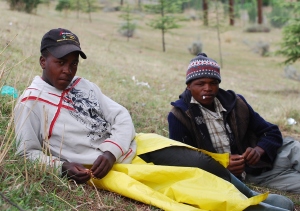
The Sesotho greeting of "Hello, brothers!" facilitated this photo of young Basotho cattle-herders at rest, minutes from our home in Maseru. (Photo: mjj)
But there’s no denying an irrefutable fact: mastering a few words in any country will garner you grins and goodwill. This is particularly crucial for a foreign correspondent like me.
For starters, Hello, Thank you, Goodbye. Or gimmicky responses like Delicious! (Even if the food is nothing to blog about.) Or Really? (To appear more engaged than you could possibly be.) Or No problem! (When things go awry, but eliciting a smile is the best response.) Or Cheers! (Which requires no explanation.)
So it is I’ve begun to study Sesotho: the language of 2 million Basotho, known individually as Mosotho, who live mostly in Lesotho, and just across the border in … South Africa. (The rhyming ends there.)
English is actually one of two national languages in this ex-British protectorate. But relying on my mother tongue wouldn’t be much fun, especially since we’ll be here three years. It’s a wise decision, says my Sesotho tutor, for learning some of the language is more than a question of being polite and respectful.
“It’s also important to know how to get yourself out of certain situations,” she tells me. Like, if I have to repel the advances of mooching cops, scheming prostitutes or superstitious witchdoctors.
Witchdoctors?! Missed that bit in my guidebook. The tutor now has my undivided attention.
Posted in "From East to East", "Mantle", "Postcard", Africa, Blogging, Central Europe, HIV/AIDS, Humor, Lesotho, Photography, South Africa | Tagged Basotho, Cantonese, Downtown Brooklyn, HIV/AIDS, Hungarian Language, Language-Learning, Learn Languages, LIU Journalism Students, Long Island University, Mosotho, Sesotho, Slovak Language, Superstitious, Witchcraft, Witchdoctors | 6 Comments »
[The following post appeared Nov. 29, 2011, on The Mantle.]
MASERU, Lesotho – There’s so much to say, I don’t know where to start. So how about with a Sesotho-language greeting: Dumela!
I moved to Lesotho just one week ago; it’s too early to explore themes and spout theories. (There’ll be plenty of time for both.) I’ll stay humble, knowing I have a hell of a lot to learn about these people, this country, this region, this continent.
Instead, I’ll stick to what I’m seeing and what I’m hearing, the experiential and the sensory, about the look of the place, the look of the people – and our dramatically different lifestyle amid both.
Lesotho is a deeply troubled place, plagued by poverty and HIV, violence against women and human trafficking, alcoholism and obesity, among many other afflictions. Nothing is more telling than the fact life expectancy for both men and women is a measly 42 to 43 years … my age exactly.
Lesotho is ravaged by the world’s third-highest HIV rate. A country of 2 million is home to an astounding 100,000 AIDS orphans. Five percent of the population? Or much higher? The scale of tragedy is unfathomable.
Funeral homes are certainly ubiquitous around Maseru. Today I asked a wiry-looking guy for directions; up close I realized he was downright skeletal. On the first day I met our housekeeper-babysitter, I asked if she had any children: “I have one son … but I had three children.” I froze, afraid to probe any further.
So, let’s turn for a minute to the positive.
Posted in "From East to East", "Mantle", Africa, Blogging, Hungary, Journalism, Lesotho, Photography, Roma, Romani, South Africa | Tagged Basotho, Domestic Violence, Expatriates, HIV-AIDS, Maseru, Obesity, Poverty, Sesotho, Sotho, Stereotypes | 7 Comments »
MASERU, Lesotho – Surreal. It’s a shopworn term – defined as unbelievable, fantastic or incongruous – that is thrown around way too casually in the Anglophone world. By me, included.
But how else to describe my sensations this past week, as I stumbled into the next stage of my life: here in remote Lesotho, the “Kingdom in the Sky” of the Basotho people?
Just two months ago, I wrapped up 17 years as a Central Europe-based foreign correspondent. The place may be rife with cobblestones and castles, age-old hatreds and poppy-seed strudel, but the post-Communist world is also perched on the doorstep of wealthy, industrialized Europe – and hitched to the fate of the European Union.
Then I spent two months in China, mostly in the hyper-developed, hyper-kinetic and hyper-counterfeiting mega-cities of Hong Kong, Beijing and Shanghai. The Chinese seem hell-bent on proving to the planet – and to themselves – that they’re worthy of the mantle “the next global superpower.”
A mere 36 hours later, via plane, train and automobile, I arrived in Maseru, the capital of Lesotho. Courtesy of my wife’s job in international development, I find myself with our three kids, for three years, in one of the world’s poorest, least-developed, and worst-HIV-ridden countries.
Posted in "From East to East", Africa, Blogging, Central Europe, China, Eastern Europe, European Union, Hong Kong, Journalism, Lesotho, Parenting, Photography, South Africa, Teaching, Writing | Tagged Afrikaans, Afrikaner, Basotho, Bratislava, Chinese Counterfeiting, Ex-Communist Eastern Europe, Freelance Foreign Correspondent, Freelancer, Makos Retes, Maseru, Mitteleuropa, Mokhoro, Poppy-Seed Strudel, Prague, Rondavel, Training | 5 Comments »
[The following appeared Nov. 18 on The Mantle. To glimpse some of the future faces of Chinese media – my students – please click here.]
HONG KONG – Last Friday, I would’ve been within my right to sleep in and relish a break from Hong Kong Baptist University. For six weeks, I’ve slavishly tutored another 79 of Asia’s brightest journalism students – mostly mainland Chinese women. (They’re worth it, but my right eye has gone blurry.)
Instead, I woke early to hydrofoil across the rocky, sun-soaked Pearl River Delta, back to the English-language United International College in Zhuhai. In a sauna of a classroom, before 20 (mostly) wide-eyed journalism undergrads, I sweat through three hours of my Parachute in! The Adventurer’s Guide to Foreign Reporting lecture: how I broke into freelancing 17 years ago, and how I’ve done it ever since.
All this, for free. For a friend. For the students … Ah, who am I kidding? I did it for me. As I returned home Friday night, thoroughly wiped, I thought to myself: “You may have an addiction to China.” Or, more specifically, an addiction to teaching Chinese journalism students.
The weekend didn’t cure me. On Monday morning, I volunteered to rise at another ungodly hour and represent our Master’s program in International Journalism at the graduation of last year’s students. I’d trained them twice: for six weeks in Hong Kong, then one week in Prague.
On stage, I enjoyed a bird’s-eye view as dozens of beaming young Chinese heard their names called and – before family and friends – marched across to receive the hearty handshake of a pair of HKBU dons.
I can’t deny it: China and her young Chinese have cast a spell on me. This country matters. Economically, diplomatically, militarily. The world’s emerging superpower is so endlessly fascinating, I’m dizzy with all that I want to write about it. Then there’s the teaching. I now hear myself utter over and over again, to anyone who’ll listen: “China matters – which means my Chinese journalism students matter, too.” The apple of my eye today is HKBU’s current crop of students.
Posted in "From East to East", "Mantle", Blogging, China, Democracy, Dictatorship, Hong Kong, Journalism, Teaching, Writing | Tagged Beijing Normal University, Censorship, Chinese Blogosphere, Chinese journalism students, Chinese Media, HKBU, Hong Kong Baptist University, Pearl River Delta, Self-Censorship, United International College, Zhuhai | 1 Comment »
[For Part I of this post, click here; for Part III, click here.]
HONG KONG – I’m not a professional photojournalist. Yet as a freelancer in the field, I recognize the value to being able to offer clients what I humbly refer to as “decent, usable” photos to package with my articles.
This semester, among the hours I spent with 14 separate groups of mostly Chinese students – cramming in myriad advice on how to professionalize their journalism blogs – I included a quickie tutorial on how to snap a no-frills portrait of their subjects. With their IPhone.
After all, if you’re off in an interesting place, interviewing interesting people, odds are your client will not muster the resources to send a photographer to retrace your steps. A headshot, at least, will a) make the story more visually appealing and b) help readers connect with your subject. Oh, and it may put a few more dollars in your pocket.
Two essential tips, then, I was taught long ago. First, turn your subject 45 degrees – get some angularity in their pose, rather than a straight-shouldered mug-shot. And second, like a hunter, don’t shoot until you see the whites of their eyes – the proverbial “window onto their soul.”
Naturally, I experimented with a guinea pig in each tutorial, to show the others. The result, it turns out, is a cherished memento for me — and a photo essay of the next generation of Chinese journalists:
Thirteen more below …
Posted in "From East to East", "Mantle", Blogging, China, Hong Kong, Journalism, Photography, Teaching, Writing | Tagged Chinese journalism students, Headshots, HKBU, Hong Kong Baptist University, IPhone, Journalism Education, Mainland China, Photography, Portraits | Leave a Comment »
[Part III of a three-part post; view Part I here, Part II there.]
HONG KONG – An Australian friend and colleague began teaching journalism this semester at Hong Kong Baptist University, and we recently commiserated over deep-fried pigeon how aggravating it is when students dare ignore our wisdom.
Since my colleague is new to university teaching in general, I preached to him the virtues of an occasional tongue-lashing of wayward students. Bouquets of praise and encouragement only go so far. Whether face-to-face or via email, I find nothing wrong with letting loose the occasional abuse – a tough love, borne of concern.
In the sanctuary of university brick and mortar, they can get away with missteps or outright mistakes. Next year, in the real world, they may pay a price. Why not scare them straight?
Since I always advocate the benefits of “show, don’t tell” through concrete example, here’s an email I sent to students during their recent reporting project — written for the class of my HKBU colleague, Robin Ewing, but which I then critiqued — on how to sensitively and professionally approach the reporting of minority communities.
Not surprisingly, it drew stony silence — though, the final articles produced were impressive overall:
Posted in "From East to East", "Mantle", Blogging, China, Hong Kong, Journalism, Teaching, Writing | Tagged Chinese journalism students, HKBU, Hong Kong Baptist University, Journalism Teaching, Tough Love, Tutorials, Tutoring, Writing Coach | Leave a Comment »
[The following piece appeared Nov. 7, 2011, in Time Out Hong Kong. It was written by my former student — and published with four of my photos.]
Three months after the Wenzhou train disaster shocked the Chinese nation, Shirley Zhao returns to the scene to speak with the survivors
WENZHOU, China – When a high-speed train crashed into the rear of another train on the evening of July 23 while crossing a viaduct in the suburbs of Wenzhou, Zhejiang province, China, Li Yu was in one of the carriages that plunged from the viaduct. It was the Mainland’s first fatal high-speed train collision, killing at least 40 passengers and injuring at least 191 people. But Li was lucky. The 43-year-old businessman escaped with a fractured right foot, several lacerations to his head and temporary amnesia.
As news of the tragedy spread throughout China, Li was rescued from the wreckage and taken to a Wenzhou hospital. With blood covering his face and most of his hair singed off, he was ushered into a lift with a doctor, his wife, who failed to recognise him. It was not until 24 hours later that she and his relatives found him through Weibo, where millions of netizens were microblogging about the disaster.
Immediately following the crash, rail officials hastily covered up rescue operations and the government clamped down on negative media coverage. These two incidents created a wave of criticism from both online communities and state-run newspapers, and confidence in both Beijing and the national rail system was severely rocked. It was a decisive moment in a socially troubled year for China.
Now, more than three months after the accident, Li is gradually completing his physical rehabilitation, but he is still putting the pieces together in his mind about what actually happened.
“It may be a good thing that I don’t clearly remember,” Li tells Time Out from the hospital’s rehabilitation room, “because it hasn’t been my worst nightmare every night. My physical wounds will recover, but it’s the psychological trauma that may never go away. Now I don’t dare to go anywhere. I’m afraid of taking planes or trains. Even when I’m sitting here, right now, I fear the walls will collapse. These things happen all too often in China.”
Posted in Blogging, China, Democracy, Dictatorship, Photography | Tagged Censorship, China's Railway Ministry, Chinese Media, High-Speed Train, Self-Censorship, Shirley Zhao, Weibo, Wenzhou, Wenzhou Train Crash, Zhejiang Province | 1 Comment »
[The following article appeared on Oct. 4, 2011, in The Christian Science Monitor. It’s the third of my three-part package to commemorate the “Red Sludge” tragedy, with Part I here and Part II here.]
Since last year’s ‘Red Sludge’ disaster, Hungary’s worst environmental tragedy, Hungarians have used the tools of democracy to seek restitution – a rarity in this former Communist state.
By Michael J. Jordan, Correspondent
DEVECSER, Hungary – On Oct. 3, 2010, Jozsef Konkoly finished installing a new heating system in his home in the Hungarian town of Devescer, in advance of winter. Overall, he’d invested a small fortune on renovations.
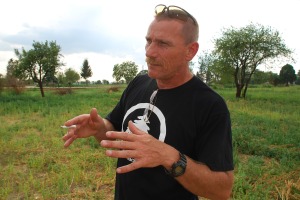
Jozsef Konkoly, standing where his home once stood, has inspired hundreds of neighbors. (Photo: mjj)
The next day, red sludge cascaded through his windows.
Mr. Konkoly is just one face of Hungary’s deadliest ecological tragedy, the toxic “Red Sludge” calamity that struck this small Central European nation last October. But one year later, he’s also become a rare – and unlikely – symbol of Hungarian democracy-in-action.
Konkoly successfully sued the factory that was responsible for the disaster, becoming an inspiration for hundreds of other ordinary folks in Devecser and Kolontar to do the same. Victims include not only those who lost homes and are now moving into new, government-built homes, but the unscathed neighbors who saw their property value collapse overnight.
At the same time, Konkoly and fellow plaintiffs illuminate a stark truth about Hungary today, two decades into the transition from Communist dictatorship to capitalist democracy: despite growing disillusion and revisionist nostalgia for a ruthless ancien régime, democracy and rule of law are slowly taking root in these post-authoritarian lands.
Posted in "Christian Science Monitor", "Foreign Policy", Central Europe, Democracy, Eastern Europe, European Union, Extremists, Hungary | Tagged Devecser, Ecological Disaster, Environment, Environmental Disaster, Industrial Accident, Jobbik, Kolontar, Magyar Aluminum, Red Sludge, Tamas Toldi, Toldi Tamas, Toxic Mud, Toxic Sludge, Toxic Spill, Tragedy, Trauma, Viktor Orban | Leave a Comment »
[The following Dispatch appeared Oct. 3 in Foreign Policy (with five of my photos in the FP Slideshow The Red Monster). It’s the second of my three-part package to commemorate the “Red Sludge” tragedy, with Part I here and Part III here.]
One year later, Hungary is still reeling from its worst-ever environmental castrophe.
BY MICHAEL J. JORDAN | OCTOBER 3, 2011
DEVECSER, Hungary—Imre Vagi, 56, doesn’t scare easily. Even when facing a flood of biblical proportions.
Vagi has scraped for survival ever since Hungary’s communist regime crumbled in 1989. As industries collapsed, he was laid off in the early 1990s by Magyar Aluminium (MAL), a huge state-owned employer in the western half of this small Central European country.
Many folks in Veszprem County are like the stocky Vagi, with his unshaven face and long sideburns, and trace their roots to the peasants who harvested holdings of the nobility, on undulating fields of potatoes, corn, wheat, even strawberries. The Catholic Church claimed the first portion; nobles, the second; and the miserable souls who’d actually picked the stuff, the last.
Agriculture has been a way of life and mode of survival for centuries, yet as the communist system disintegrated, party-run farms were also in crisis. Nevertheless, Vagi tapped into his farming genetics and in 1995 bought his own plot of five sandy hectares. By last fall, he was tilling up to 400 hectares of mostly grain, cereal, and sunflower — an impressive feat of post-communist entrepreneurship.
Then, the “red sludge” hit. On Oct. 4, 2010, MAL’s communist-era but still active reservoir of toxic waste ruptured, unleashing a crimson wave of 184 million gallons of the caustic byproduct of aluminum production. The noxious goop washed over a swath of 15 square miles, including Vagi’s land.
The first to be walloped was the village of Kolontar; 10 people drowned in the alkaline muck, including a toddler. The torrent then splashed across the town of Devecser, burning scores of victims, poisoning hundreds of homes, and killing off most of the plant and animal life in the Marcal — a tributary to Europe’s second-largest river, the Danube. It was Hungary’s worst-ever chemical accident: one part Chernobyl, one part Pompeii.
Posted in "Christian Science Monitor", "Foreign Policy", Bulgaria, Central Europe, Eastern Europe, European Union, Hungary, Photography | Tagged Devecser, Environment, Environmental Disaster, Flood, Hungary, Industrial Accident, Kolontar, Magyar Aluminum, MAL, Red Sludge, Tamas Toldi, Toldi Tamas, Toxic Mud, Toxic Sludge, Toxic Spill, Tragedy | Leave a Comment »
[This article appeared Sept. 15, 2011, on Transitions Online in Prague. It was republished Sept. 16 on Roma Transitions, and republished Sept. 22 on The Mantle.]
After years of debate, the EU unveils its first high-level policy document on the Roma. Now it’s up to national governments to fill in the outline.
By Michael J. Jordan 15 September 2011
BUDAPEST | Angela Kocze has been a firsthand witness to all the calamities that have befallen her fellow Roma over the two decades since Central and Eastern Europe rid itself of communist rule.
Nevertheless, Kocze is the rare voice to somehow muster “cautious optimism” about the first unified European Union policy to target the plight of the Roma, Europe’s largest, most-despised and most-marginalized minority.
She even swallows a grain of salt in that it’s Hungary, her homeland, that claims the new EU Framework for National Roma Integration Strategies as a crowning achievement of its just-concluded stint in the presidency of the European Union. Budapest can only hope Western partners will look more kindly upon its six-month reign, which was tainted from the outset by Hungary’s suffocating new media law.
Kocze, a research fellow in the Hungarian Academy of Sciences’ Institute for National and Ethnic Minorities, has for years heard empty – even insincere – promises from Budapest to do something about the subpar education, employment, health, and housing from which many Roma are unable to escape.
Meanwhile, the country has seen the dramatic rise of an openly racist, far-right party. In a not-entirely-unrelated development, nine Hungarian Roma have been murdered in suspected racist attacks, including a man and his 5-year-old son shot as they fled their fire-bombed home.
Yet the government of Prime Minister Viktor Orban – despite a number of overtures to the far right over the years – seems to have adopted a new stance, promoting the idea that “Hungarians should not see Roma as a problem, but as an opportunity,” Kocze says. “Something new has started, and there’s an opportunity right now that can be exploited.”
Posted in "Roma Transitions", "Transitions Online", Central Europe, Democracy, Eastern Europe, European Union, Extremists, Gypsy, Hungary, Minorities, Roma, Romani | Tagged Amnesty International, Angela Kocze, Decade of Roma Inclusion, EU Roma Framework, European Liberal Forum, Fidesz, George Soros, Janos Ladanyi, Jobbik, Kocze Angela, Ladanyi Janos, Open Society Institute, Orban Viktor, Post-Communist Eastern Europe, Viktor Orban, World Bank | Leave a Comment »
Do not follow where the path may lead. Go instead where there is no path and leave a trail. — Ralph Waldo Emerson
BRATISLAVA – This blog leaves a trail.
As a journalist with a long-time base in Central and Eastern Europe, then on to Hong Kong in the Far East, and now back and forth again.
The pendulum continues to swing. My dispatches and photos below aim to open a window onto these unique societies.
Many are third-person serious; some, first-person humorous. (At least they try to be.) When you invest nearly 18 years of your life in an exotic locale, you have to take a step back and appreciate what’s around you, in a more intimate way.
All are produced from the perspective of an American foreign correspondent, journalism teacher and freelancer raising kids overseas.
Spliced in are my recent articles. I’ve been a correspondent for the Christian Science Monitor since 1995, and contributed more recently to Foreign Policy, Harvard’s Nieman Reports, Global Post, Ms. Magazine, The Mantle and other publications listed to the right. I also pitched in with two chapters to the newly published book on the Roma minority, “Gypsy Sexuality.”
Thank you for reading! … mjj
Posted in "From East to East", Central Europe, China, Hong Kong, Humor, Hungary, Photography, Slovakia | Tagged Blogging, Central Europe, China, Ex-Communist Eastern Europe, Foreign Correspondence, Freelancing, Hong Kong, Journalism, Photography, Reporting, Teaching, Training | 3 Comments »
[The following piece appeared July 22 in TOL/Transitions Online. (It was republished on The Mantle, then republished again on Roma Transitions.) This was the first of my three-part package to commemorate the “Red Sludge” tragedy, with Part II here and Part III here.]
DEVECSER, Hungary – It was just past noon last Oct. 4, and Karoly Horvath had returned home from fishing a local lake, here in provincial western Hungary. His wife and 12-year-old daughter were home to greet him, too – just as the waves of red sludge crashed through the door and windows.
Within seconds, the toxic mud was above their waist, burning the skin. Unable to move, Karoly could only watch mother and child screaming in agony.
“It was the most awful thing,” says Karoly, 38. “As a husband and father, stuck in that red sludge, seeing that happen to them before my eyes, but being so helpless to do something about it.”
His wife, Eva, was hospitalized with burns across 70 percent of her body. At least she survived: ten were killed in what instantly became Hungary’s deadliest industrial accident ever. Greenpeace went so far as to call it one of Europe’s worst ecological disasters “in the past 20 or 30 years.”
For Hungary, the rupture of a Communist-era reservoir of aluminum waste was one part Chernobyl, one part Pompeii. In Devecser, it poured trauma upon trauma for a people already battered by years of economic hardship and political hatred. Today, though, amid the gloom is a glimmer of hope: scores of hapless victims have discovered a rare source of empowerment – the courts – to pursue compensation from the wealthy, well-connected owners of the aluminum company. This reveals a surprising appreciation for the rule of law in a country often painted as fed up with its harsh brand of democracy, two decades into the post-Communist transition.
On the flip side, though, a new strain of Hungarian resentment has recently bubbled up: at the Roma living among them, known more derogatorily here as ciganyok, or “gypsies.” The venom illuminates how embittered Hungarians have grown, especially toward Europe’s most marginalized minority.
Observers may view the Horvath family as victims. But because they’re Roma, some Hungarians harbor doubts. The mantra around Devecser is, “For many, this wasn’t a red sludge, but a golden sludge.”
Posted in "Mantle", "Roma Transitions", "Transitions Online", Central Europe, Democracy, Eastern Europe, European Union, Extremists, Gypsy, Hungary, Minorities, Photography, Roma, Romani | Tagged Accident, Aluminum, Anti-Roma Resentment, Devecser, Environmental Disaster, Golden Sludge, Hatred, Incitement, Industrial Accident, Kolontar, Red Sludge, Toxic Mud, Toxic Spill | 1 Comment »
[The following commentary appeared June 6, 2011, in Harvard’s Nieman Reports.] It was republished June 10 on The Mantle.]
BRATISLAVA, Slovakia – Western intervention in Libya – and in the Arab Spring itself – has revived debate over “exporting our values,” especially the kinder, gentler, non-militaristic forms of soft power.
Then along comes James Miller’s exquisitely timed broadside, “Questioning the Western Approach to Training,” against one of those soft-power instruments – Western journalism training – in the Spring 2011 issue of Harvard’s prestigious Nieman Reports. (Full disclosure: I’m a contributor to the magazine.)
I’m compelled to respond because Miller – a Visiting Professor at the Center for the Study of Global Media and Democracy, Goldsmiths, University of London, on sabbatical from Hampshire College – sounds like he’d dispatch with overseas journalism educators like me. There it is, in black and white, when he derides “media missionaries.”
I do indeed preach the gospel, whether to university students in post-Communist Slovakia and Czech Republic, or in Hong Kong to Chinese students from the heavily censored mainland, or to minority Roma (a.k.a. “Gypsy”) journalists in the Balkans, or to hundreds of international participants in a biennial foreign-correspondent training course in Prague. I’m not unlike the proselytizing, wholesome-looking Mormons I see around the globe, in their white shirts and black name-tags. Except I do my sermonizing in the classroom, about what I call serious, responsible journalism.
In his essay, Miller writes, “This is a time of unprecedented international efforts to codify and inculcate Western-style news reporting and editing – to train on a global scale what its proponents assertively call ‘world journalism’ – in places quite different from American newsrooms and classrooms, with nothing like the journalistic or political-cultural history of North America and Western Europe.” It’s unclear if he’s calling for a less-Western, more sensitive style to such training, or urging that it be scaled down altogether. Both views are wrong.
He cites the case of post-Communist Eastern Europe – a place I know well, after 16 years as a foreign correspondent out here. “Cold War modernization theory,” says Miller, has fostered “a surprisingly idealized version of mainstream journalism” as a “necessary means of democratization.”
My question for Professor Miller: What’s wrong with that?
Posted in "Christian Science Monitor", "From East to East", "Mantle", "Nieman Reports", "Transitions Online", Balkans, Central Europe, China, Czech Republic, Democracy, Dictatorship, Eastern Europe, Egypt, Extremists, Gypsy, Hong Kong, Hungary, Journalism, Middle East, Minorities, Roma, Romani, Slovakia, Teaching, Tunisia | Tagged "Christian Science Monitor", Accountability, Center for the Study of Global Media and Democracy, Chinese journalism students, Citizen Journalism, Colonialism, Colonialist, Czech University Students, Democratization, Egyptian Journalists, Exporting Values, George Polk Awards, Goldsmiths, Gypsy Journalists, Hampshire College, Hong Kong Baptist University, Impunity, James Miller, Joseph Nye, Journalism, Long Island University, Media Missionaries, Missouri J-School, Missouri Journalism, Nieman Reports, Post-Communist, Romani Journalists, Rule of Law, Slovak University Students, Soft Power, Tunisian Journalists, Universal Values, University of London, University of Missouri, Watchdog Journalism, Western Journalism Training, Western Training, Western Values, World Journalism | 1 Comment »
[The following post appeared June 1, 2011, on The Mantle.]
BRATISLAVA – From the slumber of their winter hibernation, I’ve pulled our bicycles from the depths of our cartoonishly overstuffed hall closet.
Dad’s self-appointed task: wipe down the dust and cobwebs, pump some life into those tires. Sure, I’ve suffered minor injuries, like a bruised shin, but I get no sympathy from this crowd.
There’s another cost, too. When you go so many months between riding a bicycle, as we did from fall to spring, certain muscles grow dormant. Guess what? They begin to atrophy. At least at my age, they do.
In the wake of that initial sojourn, then, I know I’ll feel a little achiness in the buttocks, knees and calves. So much so, I’ve begun blurting out a new slogan to anyone who’ll listen: I ain’t gettin’ any younger.
Yet, the muscle memory is there, retained. That maiden voyage flips the switch and re-activates the muscles. Soon enough, your confidence soars until even biking with little kids feels oh so natural.
Well, writing is just the same. Neglect certain skills, watch them wither.
I was thinking about this as I sat down to write another article for Harvard’s Nieman Reports. Sorting through hand-written notes, jotted in a notepad, becomes something of a chore. I find myself procrastinating. But of course I must go through these damn notes.
Posted in "Book-Writing Blog", "From East to East", "Mantle", Blogging, Central Europe, Humor, Journalism, Parenting, Slovakia, Sports, Teaching, Writing | Tagged Bicycling, Blogging, Bratislava, Children, Family, Fatherhood, Interviewing, Journalism, Kids, Memory, Muscle, Parenting, Slovakia, Teaching, Training, Writing | 2 Comments »
[The following post appeared May 20, 2011, on The Mantle.]
BRATISLAVA – At least, that’s the thank-you letter Finland should send Slovakia.
I’ve never been to a Helsinki block party. But earlier this month, for a solid fortnight of the World Hockey Championship, Bratislava sure felt like one. By the end of their two-week drinking binge, I wanted the pickled Finns to grab their gold medals and get the hell out.
I wouldn’t describe myself as a “hockey fan,” as that requires a curious affection for gap-toothed smiles – particularly among those who had involuntarily eaten a puck traveling about as fast as my car. However, I sure do love a good story. Living in tiny Slovakia, I hoped to live one through their hockey.
Slovakia spared little expense to throw a memorable bash as host of the 16-nation tournament, held every year. Hockey is a passion for this nation of only five million, with toddlers barely beyond diapers carving figure-eights on rounded hockey skates. Slovakia won the world title in 2002, and finished an eye-opening fourth at the 2010 Olympics in Vancouver.
I cheered these underdogs every step of the way, as I did their thrilling World Cup run. Meanwhile, Slovak star Marian Hossa helped lead the Chicago Blackhawks to the NHL Stanley Cup last year; the towering Zdeno Chara may soon do the same for the Boston Bruins.
The 2011 world championship would mark the first time Slovakia, independent only since 1993, had hosted alone. Finally, a chance to distinguish Slovakia from Slovenia. Hype began months ago. The wolf mascot, “Goooly,” was stationed at area malls, digitally counting down the minutes and seconds. As full-blown hockey fever hit, the national flag of red, white and blue fluttered from many cars. I came this close to buying my sons foam fingers and Dr. Seuss top hats in Slovak tri-color. I’ll take four more dust-collectors, please.
All this while officialdom weathers the arrows of the latest in a never-ending drumbeat of corruption that mars the post-Communist era, not only in Slovakia, but across the entire region. This scandal, naturally, was over the massive facelift performed on its main hockey stadium, plus the gleaming new hotel built illegally next door.
Posted in "From East to East", "Mantle", "Postcard", Central Europe, Czech Republic, Eastern Europe, Ex-Soviet Republics, Ex-Yugoslavia, Humor, Parenting, Slovakia | Tagged 1968, 1989, Alcohol, Alcoholism, Beer, Corruption, Finnish Hockey, Finnish-Russian, Finnish-Swedish, Football, History, Hockey, IIHF, Invasion, Marian Hossa, Mikael Granlund, Mikko Koivu, Nationalism, Occupation, Prague Spring, Russian Hockey, Slovak Hockey, Sports, Swedish Hockey, World Hockey Championship, Zdeno Chara | 3 Comments »
[The following post appeared May 10, 2011, on The Mantle. The post was republished May 11 on Roma Transitions.]
BRATISLAVA — The Romani people are Europe’s largest minority – and also its most marginalized. Much is written about their persecution, both historic and contemporary, especially in Central Europe today. Yet Jud Nirenberg trammels new terrain, as editor of the newly published book, “Gypsy Sexuality: Romani and Outsider Perspectives on Intimacy.” (I was delighted to contribute two chapters: one on the lack of sex education among Bulgarian Roma; the other, early-teen marriage among Kalderash Roma in Romania.)
 Via email, I interviewed Nirenberg, 39, who managed to produce this book while also working as associate director of the U.S. Association for UNHCR, the UN refugee agency.
Via email, I interviewed Nirenberg, 39, who managed to produce this book while also working as associate director of the U.S. Association for UNHCR, the UN refugee agency.
MJ: How did you first become interested in Roma issues?
JN: I’m an American of mixed Romani and Jewish descent, grew up in Massachusetts and had a fairly assimilated childhood, which isn’t really the norm for Romani Americans. There are, of course, Americans whose parents were Romani immigrants from Europe and whose lives resemble any other first-generation Americans. A lot of Roma came in the 50s from Hungary, for example. But there is a larger community of Romani Americans who are more often the subject of writing (and who are the focus of one part of this book), whose families came a long time ago and yet who live very much apart from mainstream America.
Posted in "From East to East", "Mantle", "Roma Transitions", "Transitions Online", Balkans, Bulgaria, Central Europe, Czech Republic, Democracy, Eastern Europe, European Union, Extremists, Gypsy, Hungary, Jewish, Minorities, Muslims, Roma, Romani, Romania, Slovakia, United Nations | Tagged Gypsy Sexuality, Jud Nirenberg, Roma, Romani, US Association for UNHCR | 2 Comments »
[Below is the blurb of a book to which I contributed two chapters. The first on the lack of sex education among Bulgarian Roma; the second about early-teen marriage among Kalderash Roma in Romania. This book may be purchased from Amazon.]
Gypsy Sexuality: Romani and Outsider Perspectives on Intimacy
Authors: Anne Marie Codur, Carol Miller, Jud Nirenberg, Claude Cahn, Maria Serban-Temisan, Bill Bila, Michael J. Jordan, Fernanda Amaral, Istvan Forgacs et al
Roma (Gypsy) communities are not all the same. Everywhere, however, Roma are the objects of some mixture of distrust and exoticism. This collection of essays offers rare and candid voices of Roma and non-Roma women and men on sexuality, gender and inter-racial relations. The collection explores the myths about the romantic and alluring Gypsies and some of the most controversial realities. From teen marriage to prostitution to some governments’ coercive sterilization of Romani women and with memoirs covering topics from inter-ethnic love affairs to rape, Gypsy Sexuality collects the words of poor Roma in slums alongside the writing of the community’s political and women’s rights leaders. The reader will never think about Gypsies the same way.
Available now on Kindle. Coming in paperback in April 2011 to Amazon and selected independent booksellers in Europe and the United States.
“One needs to read this attentively…This book shows the reality of Romani life…I believe that more books like this are needed.”
Asmet Elezovski, Secretary General, European Roma and Travelers’ Forum
Posted in "Book-Writing Blog", "Transitions Online", Balkans, Bulgaria, Central Europe, Eastern Europe, European Union, Extremists, Gypsy, Minorities, Roma, Romani, Romania, United Nations | Tagged Bill Bila, Carol Miller, Claude Cahn, Gypsy Sexuality, Jud Nirenberg | 2 Comments »
[The following commentary appeared March 22 on the Christian Science Monitor‘s Opinion page. It was republished March 24 on The Mantle.]
Slave Labor? I Didn’t Get Paid For This Piece — And I’m OK With That
More and more writers are publishing their work without payment in exchange for the promise of ‘prestige’ and ‘platform.’
BRATISLAVA – AOL’s tidy $315 million purchase of The Huffington Post in February produced more pity for the folks who drive much of the site’s success – the HuffPo hordes of bloggers who won’t be offered a slice of the spoils.
They are expected to continue writing for free.
Some call it slave labor. I call it fair barter. Seriously, I would write for HuffPo for free. Heck, I even agreed to write this commentary piece without compensation. [Editor’s note: Thanks again, Michael. You’re very generous.]
I’m a freelance foreign correspondent. I have a wife and three kids to help feed, and I believe that productive labor should be rewarded. So why on earth would I voluntarily submit to sweatshop conditions?
The reason is … Subscription Required for Premier Content
Just joshing. Did I have you going? The real reason I blog for free is, well, because my wife lets me. Another joke! Only partly true. Journalistic Borscht Belt, here I come. But seriously, folks. The key to why I numb myself to compensationlessness can be summed up in on word: investment.
We freelance journalists out on our own today have to “build our brand.” I can’t believe I pulled a mantra from the PR flak’s handbook, but that’s the reality today. How else to distinguish yourself amid the din of countless competing voices and social media? To survive, you have to absorb short-term sacrifice for long-term gain. Even if that means writing for free.
Posted in "Christian Science Monitor", "Mantle", Blogging, Central Europe, Humor, Journalism, Teaching | Tagged "Transitions Online", Blogging, Blogosphere, Chinese Blogosphere, Freelance Foreign Correspondent, Freelancer, Freelancing, HKBU, Hong Kong Baptist University, Humor, Journalism, Journalism Teaching, Prague, Reporting, Teaching, TOL, Training | 3 Comments »
[The following appeared March 18, 2011, on The Mantle.]
BRATISLAVA – The UN Security Council’s 11th-hour intervention to save Benghazi may have sparked a Libyan ceasefire – or brief respite – but one criticism caught my eye as Gaddafi loyalists tightened the noose around the rebel stronghold.
“There are 1 million people who believed the Western promises that said Gaddafi is no longer legitimate,” said the French philosopher Bernard-Henri Levy, who had met with rebel leaders in Benghazi.
Memories of the 1956 Hungarian Revolution come flooding back. Not that I was there, mind you. But Hungarians have for years resented the West for “promised” assistance – via the U.S. Congress-funded Radio Free Europe, the UN, and others – should Magyars take up arms against a Soviet-backed Communist regime several years into its reign of terror.
Spurred on by those words of support, the Hungarians rose up, heroically, on October 23, 1956. Except, the West never came. In Budapest, street-by-street gun battles against Soviet tanks lasted less than two weeks, before being snuffed out. The Hungarian toll: more than 2,500 killed and 200,000 refugees – including my father and grandparents.
My question is not if the international community should’ve intervened in Hungary then, or in Libya today. (As my Mantle colleague Corrie Hulse has suggested.) Rather, if you encourage others to lay their lives on the line, what moral responsibility do you bear if you ultimately fail to back words with action?
For Libya, this depends on your definition of promise. I try to imagine myself in the shoes of an ordinary Libyan who over the past month has seen: the globe rejoice at revolutions in Tunisia and Egypt; world leaders, even Arab allies, brand Gaddafi as “illegitimate” for his ruthlessness against civilians; Libya suspended from the UN Human Rights Council; French President Nicolas Sarkozy shake hands with rebel leaders and call for air-strikes; and the Arab League agree to a no-fly zone against one of their own.
If I’m Libyan, it sure sounds like the world is telling me: Keep fighting. We won’t let the Colonel get away with this. Help is on the way. Yet each day, while Gaddafi’s forces pounded and demoralized the rebels, the international community dragged its feet.
The aftermath of Hungary 1956 was marked by mass arrests, show trials, executions and long prison terms. In Libya, there seems no option but fight to the death. Imagine what revenge awaits Benghazi, after Gaddafi vowed “no mercy, no compassion.” If the ceasefire collapses and the world fiddles while Benghazi burns – as it did for Budapest 55 years ago – the blood won’t only be on the hands of its executioners.
Posted in "From East to East", "Mantle", Central Europe, Democracy, Dictatorship, Eastern Europe, Hungary, Libya, United Nations | Tagged Arab League, Benghazi, Bernard-Henri Levy, Budapest, Gaddafi, Hungarian Communism, Hungarian Refugees, Hungary, Libya, Moral Responsibility, Nicolas Sarkozy, Qaddafi, Radio Free Europe, Rebel, Revolution, Soviet Union, Suez Canal Crisis, The 1956 Uprising, UN Human Rights Council, UN Security Council, United States | 2 Comments »
[The following Postcard was republished Feb. 24, 2011, in the Jewish Exponent of Philadelphia. It was originally published March 2004 in JTA.]
By Michael J. Jordan
VITEBSK, Belarus — There’s no business like Chagall business. At least, not in the hometown of the legendary artist.
Shunned by the Soviet authorities for his leaving the “worker’s paradise” of the Soviet Union for the artistic incubator of Paris, Marc Chagall has undergone a remarkable posthumous rehabilitation in his Belarussian birthplace.
The charming provincial city of Vitebsk, an inspiration for much of the artist’s oeuvre — like his floating, dreamlike images of wood rooftops, barnyard animals and bearded fiddlers — is not only a must-see for Jewish tourists, it’s said to be a cornerstone of national tourism. Located 120 miles northeast of Minsk, the capital, Vitebsk draws German and Japanese tourists and countless foreign art students.
Hordes of schoolchildren tour the museum within the refurbished Chagall family homestead. The museum was opened in 1992 and has since been accompanied by annual “Chagall Days,” featuring music, exhibitions, lectures and poetry readings. It’s quite a turnaround for an artist revered by some, scorned by others as a symbol of dissent, and long banned from public discourse.
Chagall is now a symbol of another kind, says Vitebsk native Arkady Shulman, a Jewish journalist and amateur Chagall historian.
“Any person who emigrated was denounced as a traitor,” says Shulman, who helped establish the Chagall museum and is chief editor of Mishpoha magazine. “People didn’t know his pictures, but they knew his name, and that he was against the system. Today, more people know his art, but he’s become a symbol of a boy from a small town who became world famous.”
Posted in "JTA", Belarus, Dictatorship, Eastern Europe, Ex-Soviet Republics, Jewish, Jews, Minorities, Postcards | Tagged Artists, Artwork, Belarus, Belarussian, Bella Rosenfeld, Ex-Soviet Union, Former Soviet Union, Hadassah, Jews, Marc Chagall, Mark Zakharovich Segal, Minsk, Soviet Jewry, Vitebsk | Leave a Comment »

